In 2011, 30% renovation for Curitiba buses (in Spanish)

Source: SIBRT
El alcalde Luciano Ducci ha entregado, el pasado 24 de Octubre, en un evento en el Parque Barigüi, 161 nuevos autobuses para la Red de Transporte Integrado de Curitiba. Fue la tercera entrega del año, con un total de 434 vehículos. Los nuevos autobuses son parte del proyecto de renovación del 30% de la flota hasta diciembre, sumando 557 autobuses.
“Se trata de autobuses más modernos que van a proporcionar mayor seguridad y comodidad a la población de Curitiba para el uso del transporte público”, dijo Ducci. “A lo largo de nuestra gestión estamos invirtiendo en el transporte público para ofrecer lo mejor para nuestra ciudad”, complementó el alcalde.
El alcalde citó los ejemplos de estas inversiones, el “Ligeirão Expresso” (en color azul) y los nuevos biarticulados para las líneas express (en color rojo), que son los autobuses más grandes del mundo. Además de las líneas express, los pasajeros de líneas alimentadoras e interbarriales se beneficiarán con los nuevos vehículos.
El presidente de URBS, Marcos Isfer, dijo que el transporte de Curitiba vive un momento muy importante, con una serie de inversiones. Además de los nuevos autobuses, las inversiones se están realizando para la implementación del “Ligeirão” Norte, Este y Oeste. “Estamos modernizando el sistema, según lo que nos ha determinado el alcalde. Curitiba transportará cada vez mejor”, dijo Marcos.
La renovación, además de reducir la antigüedad promedio para 4,5 años, también alegra a los operadores del sistema. Con 15 años de trabajo como conductor del transporte público, Joel Carvalho dijo que los nuevos autobuses son modernos, seguros y representan una mejora significativa, tanto para el usuario, que gana comodidad y seguridad, como para los conductores que pasan por un entrenamiento para conducir los vehículos más modernos.
“La renovación tiene beneficios para todos y valoriza nuestra profesión”, dice Joel, que está calificado para conducir cualquier tipo de autobús. “Para nosotros es un importante paso adelante, nos pone junto con las nuevas tecnologías, es una recuperación, no hay duda”.
¿Comments? ¿Opinions? ¿Similar News? Send them to us!
Tweet
Mexico City’s Newest BRT Line Provides a Direct Link from Historic Center to the Airport

Source: ITDP
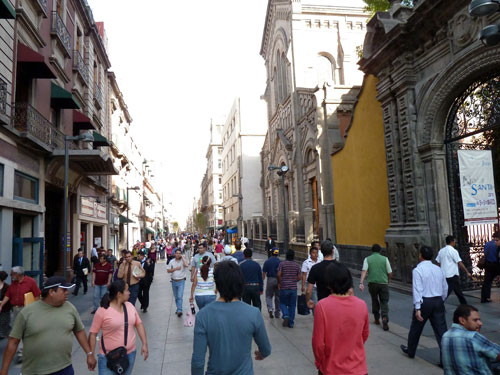 A city’s reputation is often shaped by how people perceive its center. Take New York in the 1970s. The iconic images of a seedy and downright dangerous Times Square were projected onto the city writ large. So too with Mexico City’s historic center, which contains some of the nation’s most iconic landmarks but had become neglected and rundown.
A city’s reputation is often shaped by how people perceive its center. Take New York in the 1970s. The iconic images of a seedy and downright dangerous Times Square were projected onto the city writ large. So too with Mexico City’s historic center, which contains some of the nation’s most iconic landmarks but had become neglected and rundown.
Since 2006, ITDP has worked with Mexico City to promote and provide technical advice on the restoration of the Centro Historico. In addition to the streetscape and pedestrian improvements they recommended, they also advised Mayor Ebrard that more transit would help make the neighborhood more accessible, and ultimately safer for all. They suggested a Bus Rapid Transit line that would connect the historic center with the airport and bring high quality transit to the neighborhoods west of the Centro Historico. And they pointed out how relatively easy it would be to take this line all the way to the airport, linking visitors to hotels and tourist attractions. ITDP provided assistance for a preliminary feasibility study for this line including passenger demand modeling.
The City began construction on Line 4 of Metrobus in July, and estimates it will take 6 months to complete. It will make a circuit through the historic center, running on two major north/south axes along Republica de Venezuela and Heroe de Nacozari in the north and Republica de el Salvador south of City Hall. The line will make vital direct connections to other transit including the Lines 1 and 3 of the existing BRT, the Buenavista commuter rail terminal, and both terminals of the Mexico City International Airport. The BRT is projected to reduce the travel time from the Centro Historico to the airport from 1.5 hours to just 50 minutes.
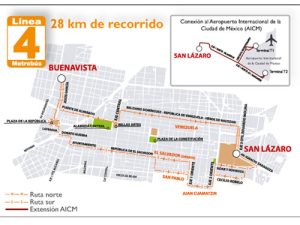
Metrobus Line 4 will have 46 Euro V, low emissions buses, and 8 hybrid buses. The buses will be low-floor, allowing passengers to board at sidewalk level, allowing for a lighter design treatment for stations, which was key for the narrow streets of the historic district.
Line 4 continues to open up transit options in the western part of Mexico City and will provide high quality, high-density transit in the Centro Historico. Over the past seven years Mexico City has made significant strides to revitalize its historic center. Metrobus Line 4 will make it easier and more pleasant than ever for people to visit and see for themselves, and might just change the way they see the entire city as well.
¿Comments? ¿Opinions? ¿Similar News? Send them to us!
Tweet
Event wrap up: Thredbo 12

The 12th International Conference on Competition and Ownership in Land Passenger Transport
11-15 September, 2011 / Durban, South Africa
This is Juan Carlos Muñoz’ testimony regarding the CoE experience at Thredbo 12:
«We had a great week at the Thredbo Conference in Durban during the second week of September. Thredbo is a fantastic Conference, not only for its amazing blend of academics, operators, agency regulators and consultants, but also because of its Workshop-based structure which “maximizes” interaction among participants (at least in comparison to all other conferences I usually attend). This is why David Hensher likes to say that everyone attending Thredbo becomes Thredbo – dependent. During the conference we had the privilege to run one of the Workshops devoted to BRT future challenges which received the highest attendance among all Workshops offered. In this very active 14-hr long Workshop on BRT, several papers were presented and we had a very lively discussion. By the end of the Workshop, we gave a plenary talk summarizing our main discussion and findings. The talk also included some BRT-related questions that remain to be answered which should be of significant interest for our Centre of Excellence.»
You can download this Workshop summary presentation here or the report here.
More info regarding the other Thredbo Workshops at the official website.
¿Comments? ¿Opinions? ¿Similar News? Send them to us!
Tweet
Graduate studies programs within our Centre of Excellence

We are inviting outstanding and enthusiastic students from all around the world to be part of our Centre of Excellence through research opportunities and internships from our institutions. These are the options available right now:
Pontificia Universidad Católica de Chile (PUC)
At PUC we offer a Master of Science, a Master of Engineering and a PhD program. In all of them students are involved with course work and a research dissertation. A graduate student involved with our Centre of Excellence would devote its dissertation to a problem related with designing, managing, operating or controlling a BRT-based transit system.
In our forthcoming research we expect to improve our understanding of economic aspects as subsidies and taxes; operational aspects as improving commercial speeds, interaction with traffic lights and avoiding bus bunching; demand aspects as route and mode choice modeling and origin destination inference from historic information; network design aspects as express service design and stop location; technological aspects as the use of cell phone information to improve our understanding of bus performance and passenger behavior. We will be offering dissertation topics on these areas to our graduate students in the coming years.
The Department of Transport Engineering and Logistics has eight professors that teach several courses in these and related areas, which can also be complemented by courses offered by other Departments. Scholarships from the Chilean government, the University and our Centre are available, as well as other financing options.
You can find more information in this document.
NEW: Two postdoc positions at PUC Chile. Find the information here.
Institute of Transport and Logistics Studies, The University of Sydney (ITLS Sydney)
The Institute of Transport and Logistics Studies (ITLS) in the Business School at the University of Sydney is a dynamic and high-quality research environment. As Australia’s Key Centre of Excellence in Transport and Logistics Research and Education, celebrating its 16th year in 2011, ITLS is recognised as a centre of excellence within Australia and is ranked among the top five institutes in the world for transport and logistics research and education. Through the establishment of the Key Centre and a memorandum of understanding signed between the University of Sydney and the University of Johannesburg, ITLS is an international collaboration at three nodes: ITLS Sydney, ITS Monash and ITLS Africa.
ITLS offers a number of postgraduate coursework programmes including the Masters of Transport Management. This is designed to provide training in the field of transport with particular emphasis on management and planning. Individual units of study focus on topics including public transport policy and planning, transport economics, and transport policy, all of which are relevant to the understanding of the role of BRT in urban transport. More details, including the wide range of available units of study, are available at this website.
ITLS invites inquires from individuals wanting to pursue higher level research in the area of BRT, whether this is a focus on theoretical or applied research in the area. This would be supported through the strong links between the institutions which comprise the CoE and the interests of Professor Hensher and Professor Mulley in developing understanding in this important area. ITLS has the largest group of postgraduate students in transport and logistics management in Australia and our postgraduate research students have excellent research facilitates and supervision by internationally renowned academic staff. More information is available at this link.
Massachusetts Institute of Technology (MIT)
MIT’s Transportation group has provided leadership in the field of transportation research for many years by emphasizing an interdisciplinary systems approach incorporating engineering, urban planning, transport system management and public policy. We are now applying this interdisciplinary approach to the concept of sustainable transportation to address the critical issues confronting the world today.
The scope of our research has broadened from a focus on the operation of existing systems to include consideration of the interactions of transportation infrastructure and operation, urban spatial structure and land use, economic growth, resource and energy use, and environmental impacts at various spatial and temporal scales. These include issues of public health and environmental impact; the loss of livability of urban areas; the uneven distribution of benefits and costs of transportation projects among different geopolitical areas, social groups and generations; and the consequences of climate change. For more information, visit our Transportation research pages and view videos of MIT transportation researchers talking about their research on MIT World.
Our goal is to contribute to the conceptualization and realization of a system in which people can readily move and effectively transport goods while facilitating economic growth and reducing environmental impacts to sustainable levels. To read about current transportation research projects, please visit the CEE Research Projects website, the Transportation@MIT institute-wide initiative, and the individual faculty websites.
The interdepartmental Master of Science in Transportation (M.S.T.) degree program emphasizes the complexity of transportation and its dependence on the interaction of technology, operations, planning, management and policy-making. Faculty members and research staff from several centers, departments and divisions within MIT are affiliated with the program and serve as research advisors and mentors to M.S.T. students.
The interdepartmental Doctoral Program in Transportation provides a structured and direct follow-on doctoral program for students enrolled in the M.S.T. program or other transportation-related masters degree program at MIT or elsewhere. The interdepartmental structure of the program allows students greater flexibility in developing individual programs of study that cross both disciplinary and departmental lines. The program is administered by the transportation faculty through the director of the interdepartmental doctoral program, who is responsible for admissions, establishment and oversight of program requirements, and conduct of the general examination and thesis defense.
The Master of Engineering transportation track covers the analysis, planning, design, operation and management of transportation systems. It offers a broad range of subjects, including methods for transportation systems analysis, transportation demand analysis, urban transportation planning, transportation and environmental limits, comparative land use and transportation planning, and logistics systems and supply chain management. Also available are subjects focusing on urban public transportation, airlines, airports, intelligent transportation systems (ITS) and marine transportation systems.
Many Master in City Planning (MCP) students from the Dept. of Urban Studies and Planning (DUSP) elect to take one or several transportation-related courses within or outside the DUSP. Also, many MCP students write a thesis related to transportation, conduct transportation-related research, and/or are advised by transportation-related faculty.
Several PhD students from DUSP conduct advanced transportation-related research, working closely with faculty in DUSP and other Departments at MIT. Students tailor their coursework to prepare for the general examinations, which require a first field of study related to the systematic approach of social inquiry (such as urban and regional economics) and a second field related to an area of application (such as transportation and land use).
The MIT Portugal node also counts with education programs in Transportation Systems: Master of Science and Doctoral programs.
Students will work on projects related to ongoing MIT research programs with agencies, industries and government, such as Transport for London, the Massachusetts Bay Transportation Authority, and the Basque Regional Government; ITS, high-speed rail and airport planning for Portugal; and the airline industry.
The interdepartmental Master of Science in Transportation, Doctoral Program in Transportation and Master of Engineering transportation track are administered through the Department of Civil and Environmental Engineering.
¿Comments? ¿Opinions? Send them to us!
Tweet
BRT News from EMBARQ Brasil

Source: EMBARQ Brasil
September and October 2011 Highlights
Several recommendations to improve operational performance of planned BRT corridors in the city center of Belo Horizonte were delivered to BHTrans. Results came from simulations that replicated current project design and operational rules of the BRT corridors that will reach the city center in 2013. BHTrans is analyzing the recommendations.
CET-Rio, the traffic agency in Rio that is also in charge of road safety, praised the EMBARQ Brasil road safety audit work. In the words of CET-Rio ´s senior analyst Dr. Eng Henrique Torres, “the importance of road safety auditing of Transcarioca corridor is unquestionable. It is the first time that such procedure is conducted for urban transport projects in Rio; by anticipating problems, crashes and deaths will be avoided”. EMBARQ Brasil pioneer work on road safety in Rio and Brazil is starting to break paradigms.
Road safety inspections in São Paulo and Porto Alegre were completed. In São Paulo, the inspection was conducted along the 10 kilometers of the Santo Amaro/Nove de Julho busway. In Porto Alegre, 35 blackspots of the 7 main busways were inspected. Carsten Wass worked with the support of EMBARQ Brasil road safety team. Final reports with recommendations should be delivered in December.
BRT Brasil, a BRT coalition is set to qualify the next generation of BRT projects. NTU, the national association of urban bus operators, invited EMBARQ Brasil to join a BRT coalition. BRT Brasil, idealized by NTU, is also formed by ANTP, IEMA and the forum of cities´ secretaries for urban mobility. BRT will be the backbone of the urban mobility projects of the next federal package of investments aimed to cities between 300,000 and 700,000 inhabitants.
Toni Lindau was invited to participate of Sustentável 2011 in Rio, an event dedicated to consolidate the Brazilian version for the World Business Council for Sustainable Development (WBCSD) “Vision 2050 report”. Further to T. Lindau criticism of the Vision 2050 report, highlighting its inadequacy to the prevailing Brazilian urban mobility reality, he was invited by Mariana Meirelles, the deputy director of the Brazilian Business Council for Sustainable Development – CEBDS – to participate of a high level committee that will review Vision 2050 report. The aim of Vision 2050 is to rethink the roles that business must play over the next few decades to enable society to move toward being sustainable. This endeavor has resulted in a call to action that aims to encourage companies to reinvent themselves, their products and services to get where they and society want to be.
Toni Lindau mediated a BRT session dedicated to international BRT experiences at the 18° National Conference for Traffic and Public Transportation in Rio. The session convened an attendance of 200 people including national & international experts and Brazilian decision makers (operators and public authorities). Part of the discussions was dedicated to understanding the limiting performance of the Transmilenio system in Bogota, currently the highest bus capacity in the world. EMBARQ Brasil is supporting the development of the concept for Rio´s TransBrasil BRT corridor that will have demands close to Transmilenio.
¿Comments? ¿Opinions? ¿Similar News? Send them to us!
Tweet
Two years of successful run

Source: The Times of India
AHMEDABAD: When chief minister Narendra Modi flagged off the first Bus Rapid Transit System (BRTS) bus on Chandranagar-RTO route on October, 14, 2009, there were slight apprehensions about its success. The BRTS experiment in New Delhi had just flopped. But, two years on, Janmarg has beaten all expectations and turned into a lifeline for lakhs of commuters in the city, ferrying 1.40 lakh daily in a fleet of 77 buses.
Ahmedabad Municipal Corporation (AMC) officials say that 2012 will be a landmark year for the project as 44 kms additional route in and around Ahmedabad will be completed, thus doubling the capacity of current operations.
AMC also plans to introduce prepaid smart cards to commuters, a practice that’s globally prevalent. While the original idea was to provide the cards as Diwali gift this year, the scheme will now be materialized in early 2012. Utpal Padia, deputy municipal commissioner and executive director, Janmarg, told TOI that the trials carried out on the new corridors have been satisfactory. The barriers used along with the smart cards have been ordered from China and will soon be installed at the existing BRTS stops after educating people about their use, said Padia.
Talking about two years of BRTS, the official said, «We got good support from the citizens. BRTS has put Ahmedabad on world map and got us many laurels and awards in these two years. There were many challenges that we overcame and there are various issues on which the work is on.»
«We project the revenues from BRTS to go up to almost double to Rs 14-15 lakh and ferry 3 lakh to 4 lakh passengers on daily basis,» said Padia.
BRTS has won accolades from international experts. Walter Hook, executive director, Institute for Transportation and Development Policy (ITDP), who was one of the earliest transportation experts involved in BRTS project, gave thumbs up to the project during his recent visit and said that with some changes, the project can match gold standard of rapid transit systems world over.
¿Comments? ¿Opinions? ¿Similar News? Send them to us!
Tweet
Five cities in the USA where mass transit riders are richer than drivers

Source: The Atlantic Cities
People who ride public transportation in American cities tend to have lower incomes than those who commute by car. But the general rule of commuter wealth disparity does have exceptions. Cap’n Transit performed a very smart analysis of 2010 American Community Survey data, freshly released by the U.S. Census, and found five metro areas where transit riders actually make more than auto commuters. A lot more. Like, in one case, nuclear physicist more. The data shake down like this:
| Metro Area | Overall median income | Drove alone median income | Public transportation median income |
| Idaho Falls, ID | $26,120 | $25,607 | $61,214 |
| Torrington, CT | $41,136 | $41,540 | $82,431 |
| Kingston, NY | $32,344 | $35,289 | $60,748 |
| Bremerton-Silverdale, WA | $35,024 | $35,371 | $52,946 |
| Poughkeespie-Newburgh-Middletown, NY | $38,048 | $41,462 | $56,351 |
When commute times are added to the picture, things get even more strange. The average commute for drivers in Idaho Falls is about 20 minutes, while transit commutes take about 70. In Torrington, drivers take about a half hour to reach work and transit riders take an hour, and that’s just about the case in Bremerton-Silverdale too, at 26 minutes by car and 67 by transit. The difference is even greater in Poughkeepsie — half hour by car and 80 minutes by mass transit — and things are similar in Kingston, which is farther north along the Hudson.
So what inspires a comfortably paid worker to ditch his or her car for a public ride? Well four of the situations can (most likely) be chalked up to the pull of a nearby major city. In these cases, the pay from city jobs is high enough to entice workers from afar, and the quality of public transportation is high enough to deter them from making the long drive. In addition, those who do drive to work probably stay local, which brings down the average drive time.
It’s easy to see how that’s the case with Poughkeepsie, which is located on the Hudson Line of the comfortable (by transit standards) Metro North commuter service. Residents of Kingston can commute into New York (or Albany) by bus or Amtrak. Bremerton-Silverdale is just across the Puget Sound from Seattle, which is accessible by ferry. Torrington is a bit harder to explain. Cap’n Transit suggests it forms an outer ring of New York City; if that’s the case, the commute should be longer than an hour, since it takes 45 minutes by bus to reach New Haven, which is still an hour and a half from New York on Metro North. Bus riders into Hartford may instead be the source the discrepancy.
The most interesting case is Idaho Falls. What would pull commuters away from the largest city in Eastern Idaho? Well there’s a clear answer: the Idaho National Laboratory, a leading research and development arm of the Department of Energy that employs roughly 4,000 workers. Much of the campus is considerably west of Idaho Falls, so the lab has an expansive fleet of buses to carry employees into and out of the city:
Today INL’s fleet consists of 103 buses, maintained and operated by 116 employees, of which 92 are drivers. The fleet logs more than 2 million miles annually (down from a peak of some 6 million miles yearly in the early 1990s). They haul roughly 2,750 passengers to the Site and back each day. And somewhere across eastern Idaho, an INL bus is on the road, nearly 24 hours per day, seven days a week.
The number of routes serviced by the fleet is incredible, though in late September the company announced it was implementing a park-and-ride program intended to shorten some of the trips. So INL has a tough question to ask itself: save on the cost of 100,000 gallons of fuel a year, or keep the top spot on the commuter income disparity rankings. Pretty, pretty, pretty tough question.
¿Comments? ¿Opinions? ¿Similar News? Send them to us!
Tweet
Montgomery looks to busways to ease traffic

Source: The Washington Post
 Montgomery County is considering building a 150-mile network of dedicated bus lanes to move its growing population more quickly while easing traffic congestion, but even supporters won’t use the “B” word.
Montgomery County is considering building a 150-mile network of dedicated bus lanes to move its growing population more quickly while easing traffic congestion, but even supporters won’t use the “B” word.
Planners, developers and local officials analyzing how to build and pay for the express bus network say they are acutely aware that buses conjure up images of slow, unreliable, second-class transit. Their pitch: Picture these buses as trains on rubber tires.
“We want riders to view it much more like rail,” said Dan Wilhelm, who oversees transportation issues for the Montgomery County Civic Federation and serves on a county transit task force.
Supporters say that Bus Rapid Transit, or BRT, would provide the convenience, comfort and reliability of light rail without the heftier cost. Plush buses would run frequently, mostly in their own lanes in the middle of local streets, and get longer green signals at intersections. Stations spaced about a half-mile apart would have rain shelters and ticket kiosks. The buses would also be low to the ground to provide fast, level boarding directly from platforms.
BRT is the fastest, most affordable — and perhaps only — way to make a significant dent in traffic, advocates say.
“There is no other way you’re going to do it,” said Montgomery Council member Marc Elrich (D-At Large), who has been pushing for BRT since 2007. “You don’t have money to build a rail system. You’re not going to bulldoze neighborhoods to build new roads.”
Montgomery officials aren’t the only ones looking into BRT’s feasibility. Regional transportation planners have proposed building a network of high-occupancy toll lanes along local highways and major arterial roads that buses and toll-paying vehicles would use.
Toll revenue would pay for construction and subsidize the express bus service, said Ronald F. Kirby, transportation planning director for the Metropolitan Washington Council of Governments.
“The driver here, really, is what can we do in the next 20 years that would make a significant impact?” Kirby said. “These are things that are doable — not easy, but doable.”
If Montgomery officials find the money for their own local network — and that’s a big “if” in today’s tight economic climate — they say all 150 miles of busway could be operating within a decade. One preliminary study predicted that the network would cost $2.5 billion in today’s dollars to build, excluding land acquisition. Although that price would make it one of the more costly transportation projects in the Washington region, supporters say, the money would spread further. Its estimated per-mile cost of $16.6 million would pale in comparison to about $120 million per mile to build light rail and $230 million to $270 million per mile to extend Metrorail.
The idea is gaining traction among key political players who are frequently at odds on transportation solutions. They include planners seeking to accommodate population growth, local officials hoping to lure new jobs, environmentalists trying to reduce carbon emissions, civic groups wanting traffic relief, businesses trying to improve workers’ commutes and developers who want to get building plans approved.
Montgomery officials say they also fear the county will lose jobs and investment to Northern Virginia, where a Metrorail extension is under construction, the Capital Beltway is getting 14 miles of new high-occupancy toll lanes and Tysons Corner is being redeveloped into a more walkable, transit-oriented community.
Supporters say Montgomery could form a “Science & Health Triangle” with BRT connecting major employers, such as the National Institutes of Health and Walter Reed National Military Medical Center in Bethesda, the emerging “science city” in Gaithersburg and the Food and Drug Administration complex in the White Oak area of Silver Spring. Developers in North Bethesda’s White Flint area say BRT would attract businesses and residents to clusters of high-rises being planned.
“People in high-rise buildings expect to drive less, and they need accessibility,” said Evan Goldman, a vice president for Rockville-based Federal Realty, which plans to redevelop the Mid-Pike Plaza shopping center in North Bethesda into about a dozen high-rises.
Even with growing support, Montgomery’s BRT proposal is still in its infancy, and much more detailed engineering will be necessary to determine routes and station locations as well as whether streets could accommodate a single, reversible bus lane or a double busway. Opposition often surfaces during that more detailed phase of planning, when residents learn who would lose parts of front yards. Task force members said they will recommend that bus lanes not take asphalt from motorists, which would snarl traffic even more.
The biggest question will be how to pay for it.
The task force appointed by Montgomery County Executive Isiah Leggett (D) is expected to have a financial plan ready by February. Elrich said he expects most of a BRT network would be paid for with local money. That would include paying off long-term bonds through an additional tax on commercial property owners who would benefit from the system, similar to special taxing districts in Northern Virginia that are helping to fund construction of the Metrorail extension to Dulles International Airport.
The BRT plans are separate from a proposed 16-mile Purple Line light rail link between Bethesda and New Carrollton and a 14-mile Corridor Cities Transitway being planned for the Interstate 270 corridor in upper Montgomery. State transit officials plan to compete for federal and state funding for both.
Key to BRT’s success, local officials say, will be finding enough money to build and operate a system that will remain fast and reliable enough to lure motorists onto buses. Critics of BRT have said some of the 20 or so other U.S. transit agencies that operate what they call BRT lines erred on the cheap side, such as leaving buses mixed with traffic and giving riders little extra comfort or convenience.
Montgomery’s BRT advocates say they would market their BRT as premium public transit. David Anspacher, a senior planner on one of the county’s BRT studies, said that built correctly, BRT shouldn’t be a tough sell.
“When folks see buses running down Rockville Pike while traffic is stopped,” Anspacher said, “that will be our best marketing.”
The Montgomery County Planning Department will hold a community meeting about its BRT study from 5:30 to 8:30 p.m. Oct. 24 at its headquarters, 8787 Georgia Ave. in Silver Spring.
¿Comments? ¿Opinions? ¿Similar News? Send them to us!
Tweet
¿Cuánto Falta?: Transantiago bus time estimation app for iPhone

 A design student from Pontificia Universidad Católica de Chile, Radu Dutzanun, developed this iPhone app very useful for the ones living in Santiago, Chile. It is described as: «Find out when is the next Transantiago bus coming and how far it is from your bus stop. It’s easy, and you only need an Internet connection!«. It has improvements from the twitter service offered by Transantiago, such as the possibility of saving your frequently used stops.
A design student from Pontificia Universidad Católica de Chile, Radu Dutzanun, developed this iPhone app very useful for the ones living in Santiago, Chile. It is described as: «Find out when is the next Transantiago bus coming and how far it is from your bus stop. It’s easy, and you only need an Internet connection!«. It has improvements from the twitter service offered by Transantiago, such as the possibility of saving your frequently used stops.
You can download it here and obtain further information at the official blog (in Spanish).
¿Comments? ¿Opinions? ¿Similar News? Send them to us!
Tweet
Opinion Pieces: The continuing saga on road pricing – can we convince the politicians?

Opinion Pieces: since 2007, Prof. David Hensher has written an opinion column in the Australasian Bus and Coach magazine, where he monthly discusses a lot of different transport-related hot topics. In this section we are revisiting these columns.
March 2011
Roads are possibly the most underpriced in terms of user contributions of all the public assets that we avail ourselves of. Regardless of whether some believe that governments should provide more road capacity to combat traffic congestion, it is an undeniable fact that if we provide more capacity under the existing road user pricing regimes (registration and fuel pricing only), then more cars will use the roads, quickly using up the additional capacity. The great sadness about all of this is that there is a presumption that we all have rights to enter the traffic and delay all other motorists, yet not contribute to the true cost associated with delay and lost time – the curse of congestion. It is estimated that over $9 billion a year is wasted in lost travel time or avoidable congestion costs, increasing to around $20 billion by 2020. This results in a predictable ‘tragedy of the commons’.
Many motorists argue that they pay enough anyway. But do they? There is enough evidence to suggest that they do not, for if they were being charged to use the roads at a level that is efficient then we would avoid much traffic congestion. Many politicians still believe (as a result of their actions) that roads should be free (toll roads being the exception); however “free” roads are not really free – the choice is between paying with time and frustration, or with money. Feel free to oppose it, but do not complain about the traffic. Opposing efficient pricing means you are choosing to endure continual congestion problems.
What we need to do in sorting out the pricing challenge is not to add a congestion charge on top of existing charges, but to undertake a complete overhaul of the entire charging regime, with options to replace some of the fixed charges (e.g., annual registration) with a usage charge based on kilometres driven by location (and vehicle emissions), so that those who obtain the greatest benefits (such as time savings) should contribute proportionally. This then would be a fair system in contrast to the current system of registration and fuel taxes, which is far from fair. Pundits who claim a congestion charge is not fair should carefully think about how fair the existing system is? Why should we all pay the same registration fee for a class of vehicle when we all travel different annual kilometres on the roads, at locations where congestion varies from nothing to significant?
The future of public transport must surely be linked to this tragedy of the commons if one believes in the adage that ‘to make public transport more attractive we have to make the car less attractive’.
Food for thought
¿Comments? ¿Opinions? ¿Similar News? Send them to us!
Tweet
Universal Access to Bus Rapid Transit: Design, operation, and working with the community

Source: World Streets by Tom Rickert, Executive Director, Access Exchange International (USA)
The ability of Bus Rapid Transit systems to serve persons with disabilities in less wealthy countries seemed obvious at first glance. The earliest graphics of BRT trunk lines in Curitiba, Brazil, depicted wheelchair users crossing boarding bridges into articulated buses. Problem solved! Thus, years later, many may be surprised to find cities where wheelchair users are unable to access one or another BRT system.
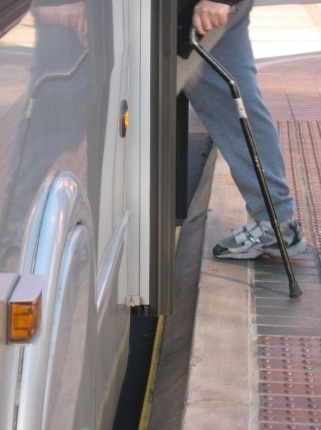 Other beneficiaries of universal design – including older persons, women, children, and those with hearing or sight impairments – are often not heard from. They just quietly decide they cannot use Bus Rapid Transit to get where they need to go.
Other beneficiaries of universal design – including older persons, women, children, and those with hearing or sight impairments – are often not heard from. They just quietly decide they cannot use Bus Rapid Transit to get where they need to go.
What happened? Why have the apparent advantages of BRT systems become problematic in many cases? It turns out the devil is in the details. But first, the positive news.
Bus Rapid Transit trunk lines are indeed a historic step forward, especially in cities in developing countries where they may represent the first large-scale application of inclusive design to any public transit system. Accessible sidewalks, curb ramps, grade-level crossings, tactile guideways and tactile warning strips all make their appearance, along with visual and audio signage and, above all, floor-level boarding – features which are there to be witnessed and copied elsewhere for decades to come.
Along with these advancements come safer and better lit stations, easier fare payment, and other features that meet the needs of seniors, women, children, tourists, blind persons, those with low vision, and people who are deaf, deafened, or hard-of-hearing.
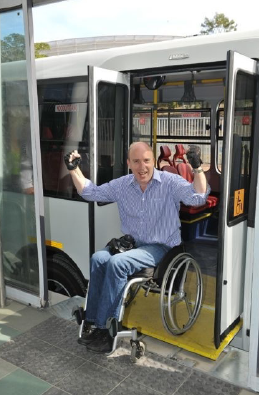 From this perspective, a well designed BRT system can appear to be an island of accessibility in the midst of a sea of inaccessibility. And therein lies part of the problem: the different elements of universal access are often considered in isolation from each other when, in fact, they all form the social, operational, and built environment required for an accessible trip chain from trip origin to the BRT trunk line, into the bus, and on to the trip destination.
From this perspective, a well designed BRT system can appear to be an island of accessibility in the midst of a sea of inaccessibility. And therein lies part of the problem: the different elements of universal access are often considered in isolation from each other when, in fact, they all form the social, operational, and built environment required for an accessible trip chain from trip origin to the BRT trunk line, into the bus, and on to the trip destination.
To illustrate how the details of design, operation, and outreach interact, we are presenting three composite case studies* of the experience of typical passengers in Latin American, Asian, and African cities.
* Click here for full article from Access Exchange International in San Francisco.
¿Comments? ¿Opinions? ¿Similar News? Send them to us!
Tweet
Opinion: China's transit historic opportunity

by Juan Carlos Muñoz
China is missing a historic opportunity to change a western-based paradigm that is causing tremendous problems worldwide. Cities are supposed to be efficient solutions for people’s interaction. However, once cities are structured around the private car, these efficiencies are threatened by the congestion, pollution, accidents, stress, obesity, little social interaction that cars cause and the significant energy consumption and urban space that they demand. At the city level, the car is an individualistic transport mode that often prevents more efficient collective modes from flourishing. Thus, cars take the city as a hostage benefiting mostly the more affluent social classes. The high densities and the political and administrative system in China offer a big opportunity to promote collective and non-motorized transportation modes. In cities with the size of Shanghai and Beijing this is the only possible path to structure the cities towards sustainability and a very attractive one.
Cities in China should not be organized to satisfy car users, but instead around the people and their children, fostering non-motorized and public transport modes, and providing infrastructure for parks and social interaction. Thus, car use should be hindered in large cities, particularly in peak periods that define the infrastructure and the fleet required to provide the mobility demanded. Many instruments are available, such as congestion pricing, parking prohibition and higher fuel taxes. This does not require investments, but a lot of determination, political will and good management.
A transport system is composed of infrastructure, vehicles and a management system. China has made a huge effort in the last decades to improve first its infrastructure and second its equipment. However, the management, control and regulation are lagging behind. The government should realize that the infrastructure and vehicles should be used wisely to obtain maximum performance.
In large cities, we should make every effort to leave the cars out of the equation and foster more efficient transportation modes. China has the density and the cultural philosophy to change the rules of the game and bring a new paradigm. It should resist the inertia of business as usual and give the western world a lesson by promoting a totally new sustainable (social and environmental) urban development alternative.
¿Comments? ¿Opinions? ¿Similar News? Send them to us!
Tweet
Photo Essay: A Tale of Two Bus Systems in Bogotá

Source: The City Fix by Gwen Kash. All photos by Gwen Kash.
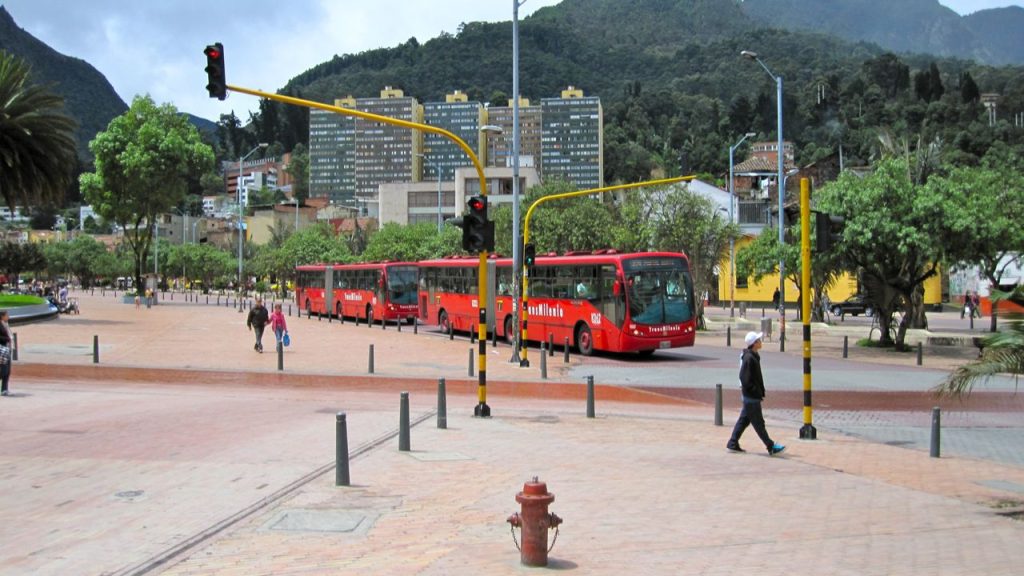
The TransMilenio’s distinctive red buses have transformed the landscape in Bogotá
More than a decade after its inception, Bogotá’s pioneering TransMilenio BRT system carries 1.6 million passengers every weekday. Its many successes, such as reducing pollution, improving safety and reducing travel time for Bogotanos, may be familiar to regular readers of TheCityFix and our website. However, TransMilenio has not been a complete solution for public transportation in Bogotá. Only 26 percent of transit trips in the city are made on TransMilenio. The other 74 percent of transit trips are made on what is known locally as Collective Public Transport, a chaotic network of buses operated by thousands of individual owner-operators organized into 66 different private companies.
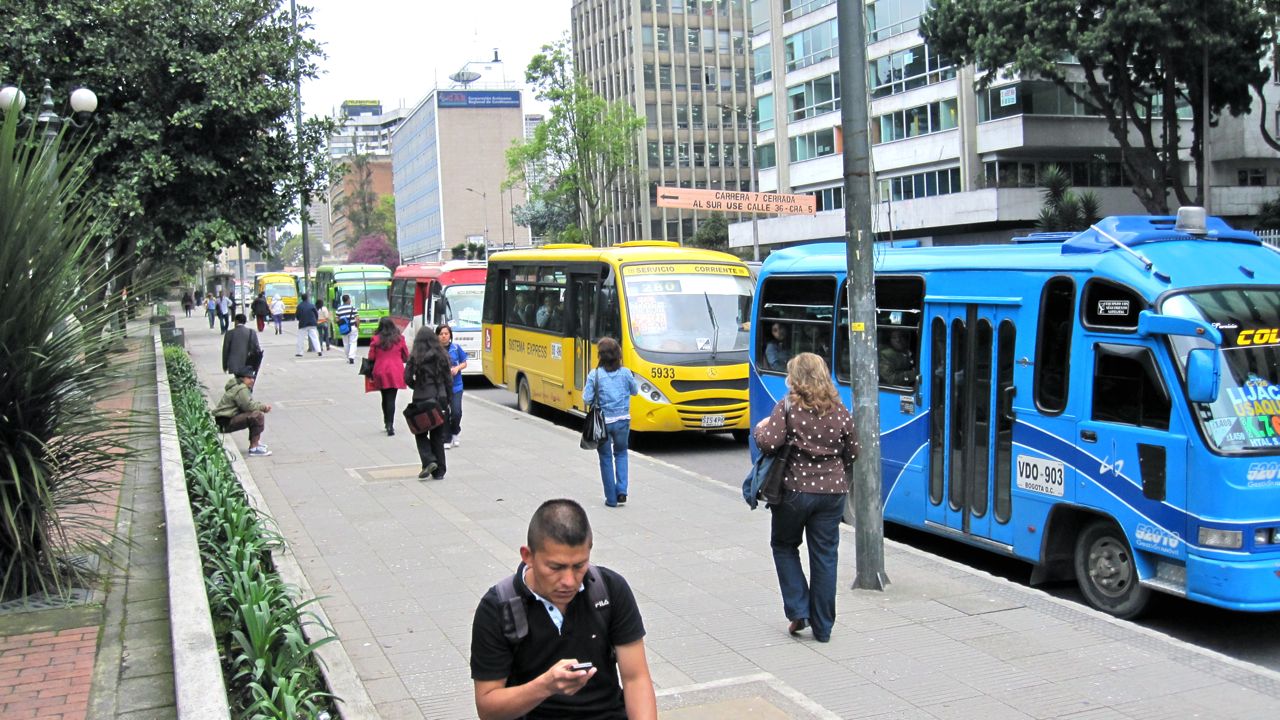
Collective public buses operating on Carrera Séptima
This disorganized and inefficient method of providing public transportation has high costs for Bogotá’s residents. What most experts consider an oversupply of buses clogs the streets with excess vehicles and fill the lungs of residents with exhaust. Since drivers earn their living from the fares they collect rather than a fixed salary, they compete with each other in “the war of the penny.” This conflict results in unsafe driving as vehicles jockey for passengers. The problem is compounded by the fact that drivers commonly work 14- to 16-hour shifts. The results of this situation are lethal: a Bogotano dies from a collision involving a collective public bus on average once every three days.
Bogotá’s transportation network is about to undergo a transformation even more radical than that wrought by TransMilenio. The Integrated Public Transport System (SITP) is scheduled to begin operations at the end of this year.
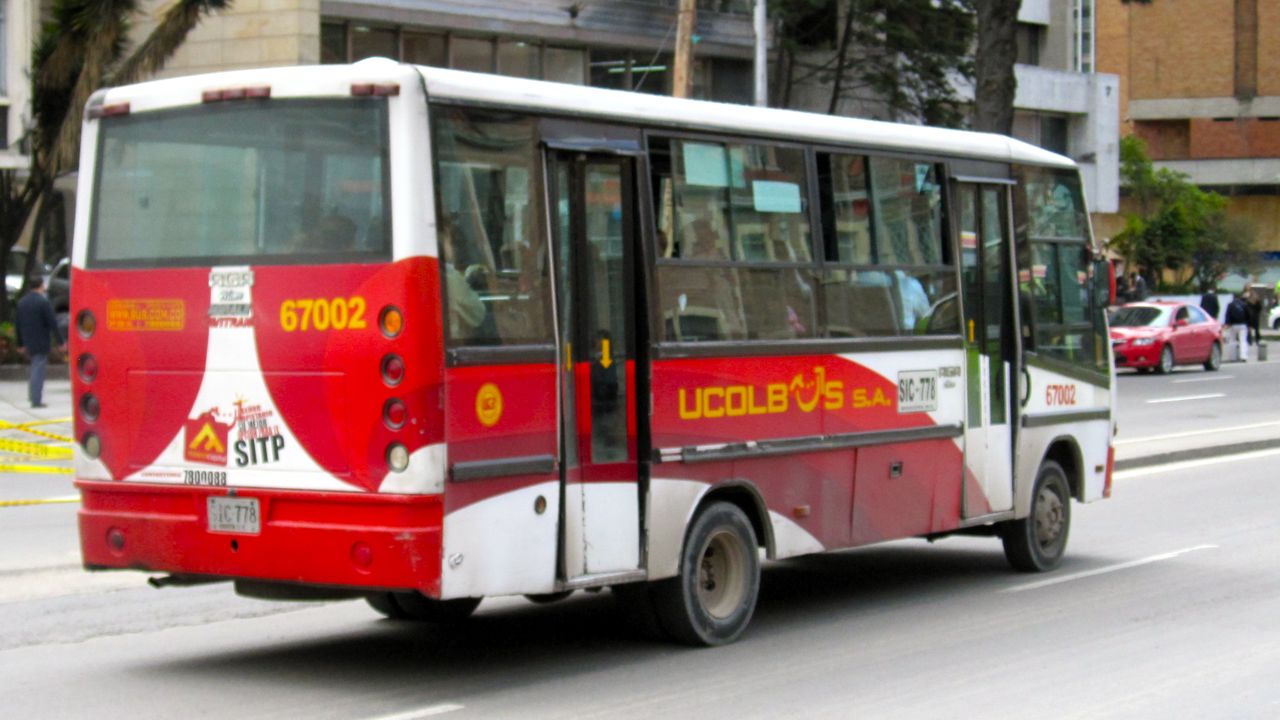
One of the buses that will continue operating as part of SITP
The SITP represents a fundamental shift from a decentralized, chaotic network to a true coordinated system. The business structure will be modeled on the successful example of TransMilenio, with responsibility for providing service shared between 13 companies who were awarded zonal concessions through a competitive bidding process. In addition to continuing the management of TransMilenio BRT and constructing several new BRT lines, TRANSMILENIO S.A. (a city-owned company) will coordinate operations between the SITP operators. The employment of bus drivers will become formal, with a fixed salary and bonuses for safe, effective operating replacing the era of survival of the fittest.
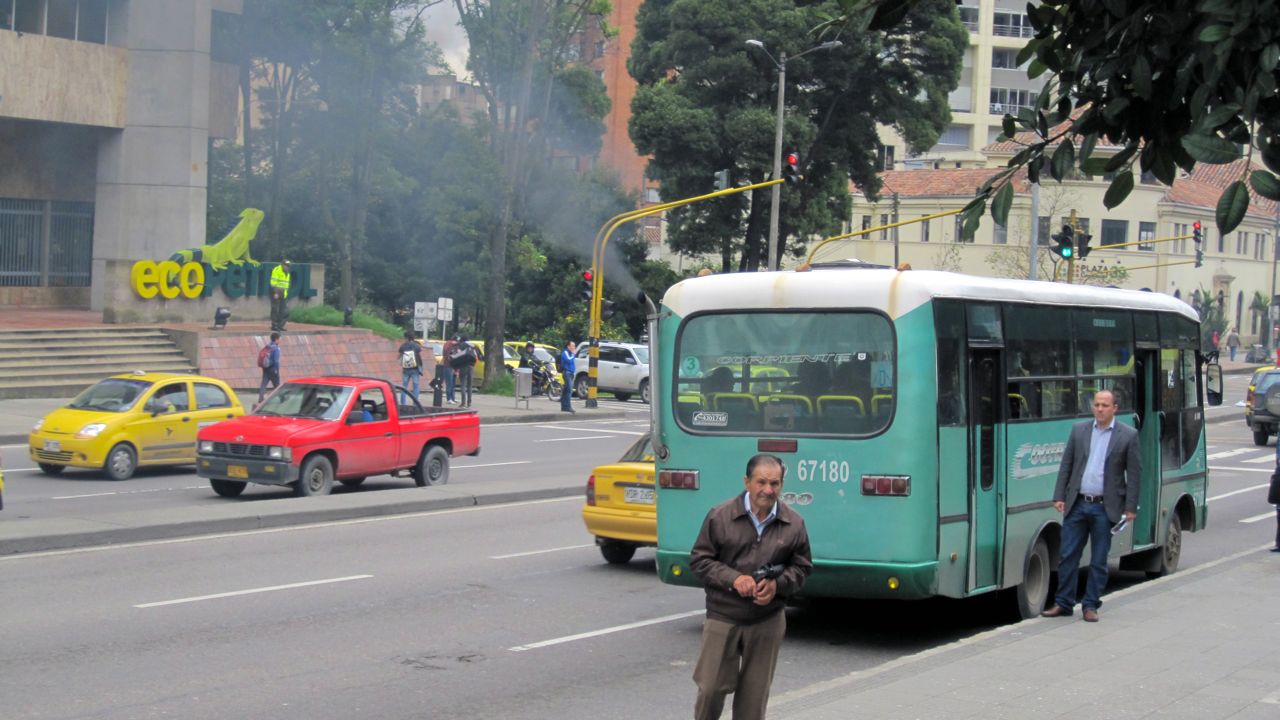
Many collective public buses emit visible clouds of smoke upon acceleration
SITP is expected to significantly reduce emissions in Bogotá. Rather than being allowed to operate for as long as two decades, buses will be retired after a maximum of 12 years. The oldest, most polluting buses will be taken off the streets as Bogotá reduces the size of its vehicle fleet by 30 percent. The fleet will be gradually upgraded to newer, more efficient models. The remaining buses will operate when and where they are needed rather than all day every day.
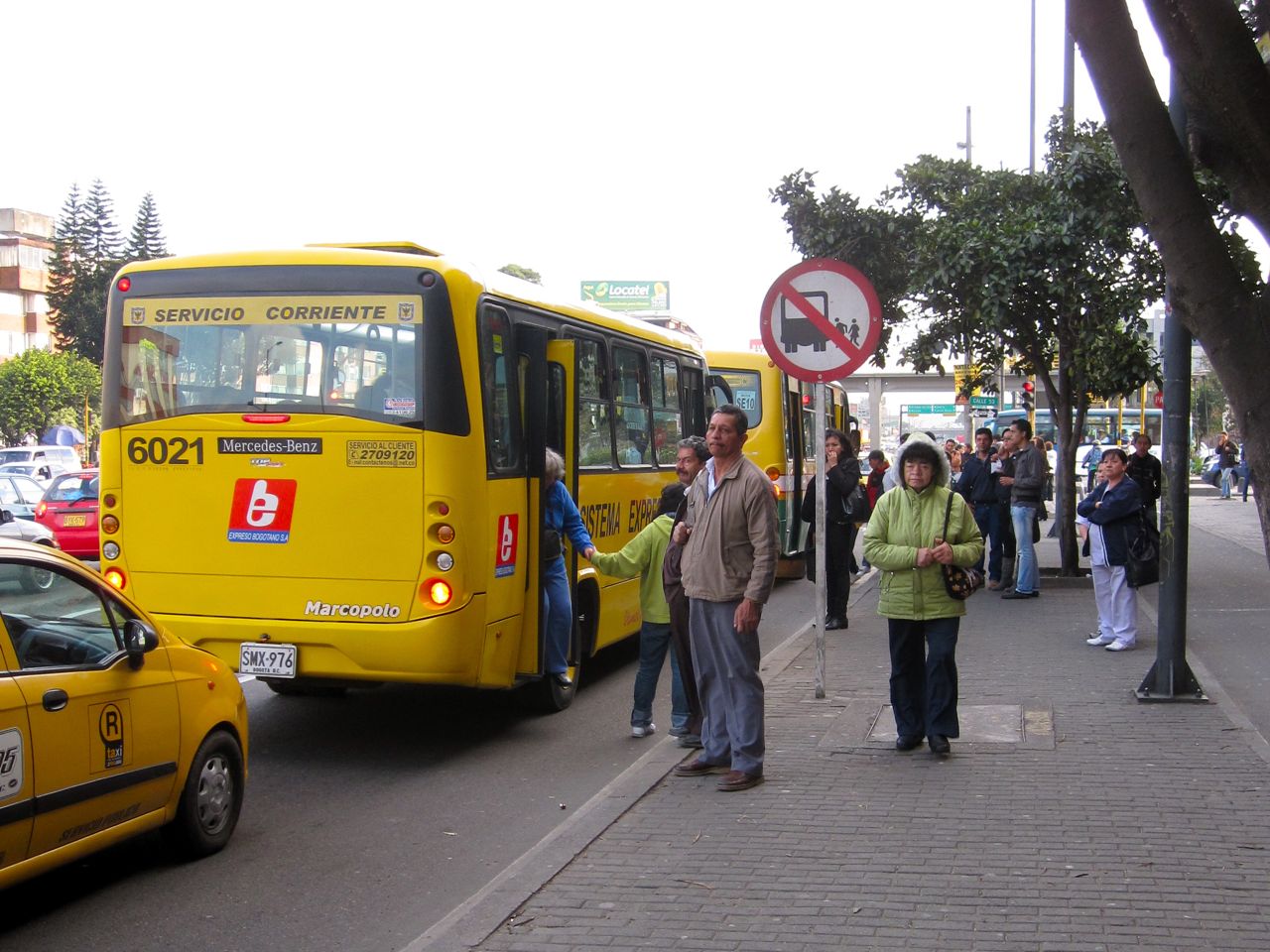
Passengers exiting a bus on Ave. Boyacá
SITP will also increase the organization of transportation in Bogotá. Currently, passengers flag down buses as if they were taxicabs. When passengers request a stop, buses grind to a sudden halt whether they are at a designated bus stop or in the middle of traffic on a crowded artery. After SITP is implemented, passengers will enter and exit buses only at designated stops; more than 2,000 are scheduled to be built. The increased order on city streets will likely result in fewer deaths from preventable collisions.
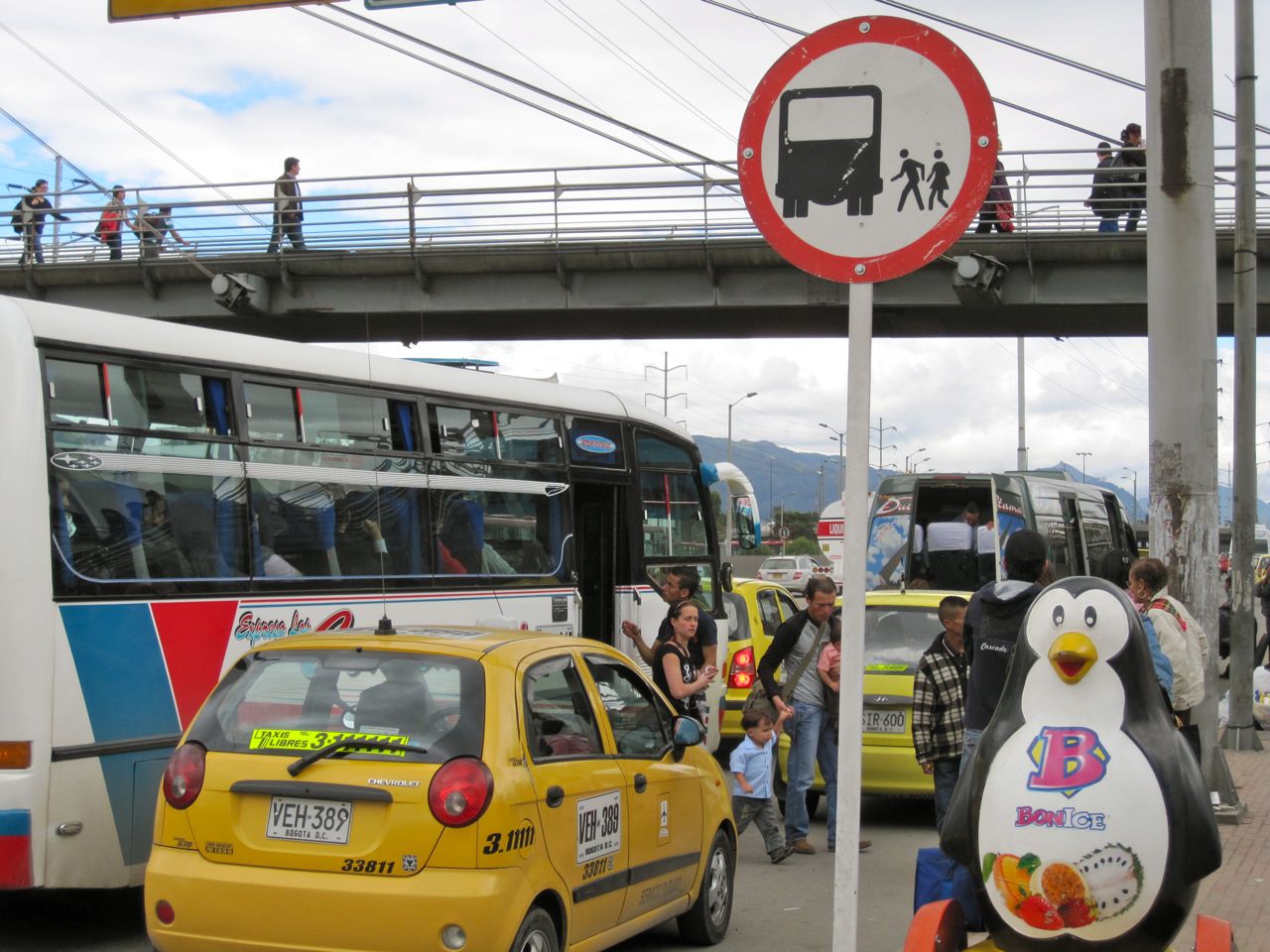
Passengers exit into traffic at a designated bus stop on the Autopista Norte
In order to function effectively, the SITP will require a transformation of the culture of transportation in Bogotá. For example, users must become accustomed to walking a few extra blocks and drivers must work as part of a team rather than as enemy combatants. SITP’s operators will conduct extensive driver training, and TRANSMILENIO S.A. is planning an education campaign to communicate the message “user by user,” as SITP director Javiér Hernández puts it.
User information will be greatly improved. Currently, the only known publicly available bus map is more than 300 pages long. SITP is streamlining routes with feedback from local resident committees and developing strategies to ensure that people don’t feel “lost” in their own city, an issue with a similar reform in Santiago, Chile. The improved user information and reliability of service, as well as an integrated farecard, are expected to improve convenience and ease of use for passengers.
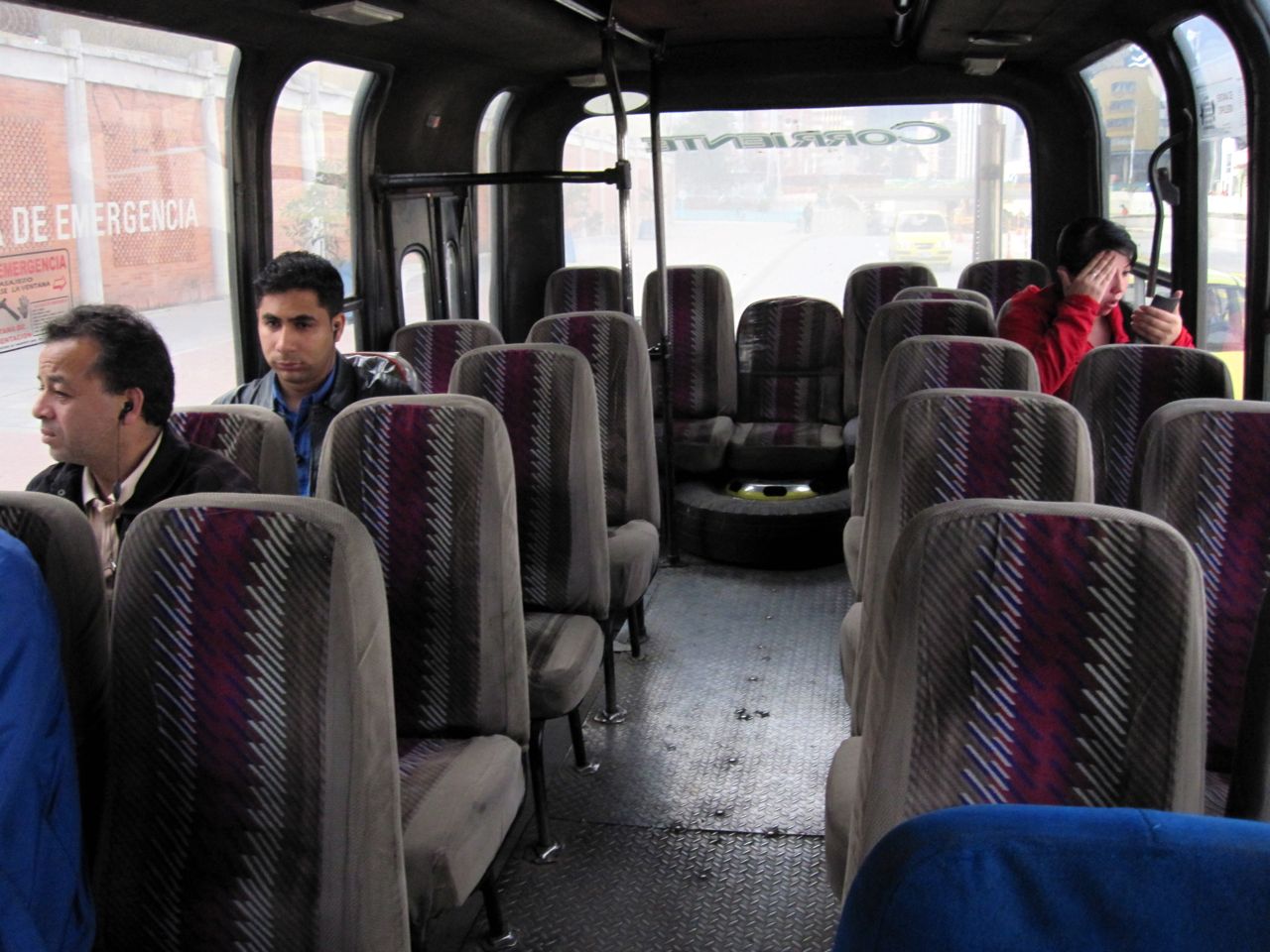
A Collective Public Bus on Ave. El Dorado during rush hour
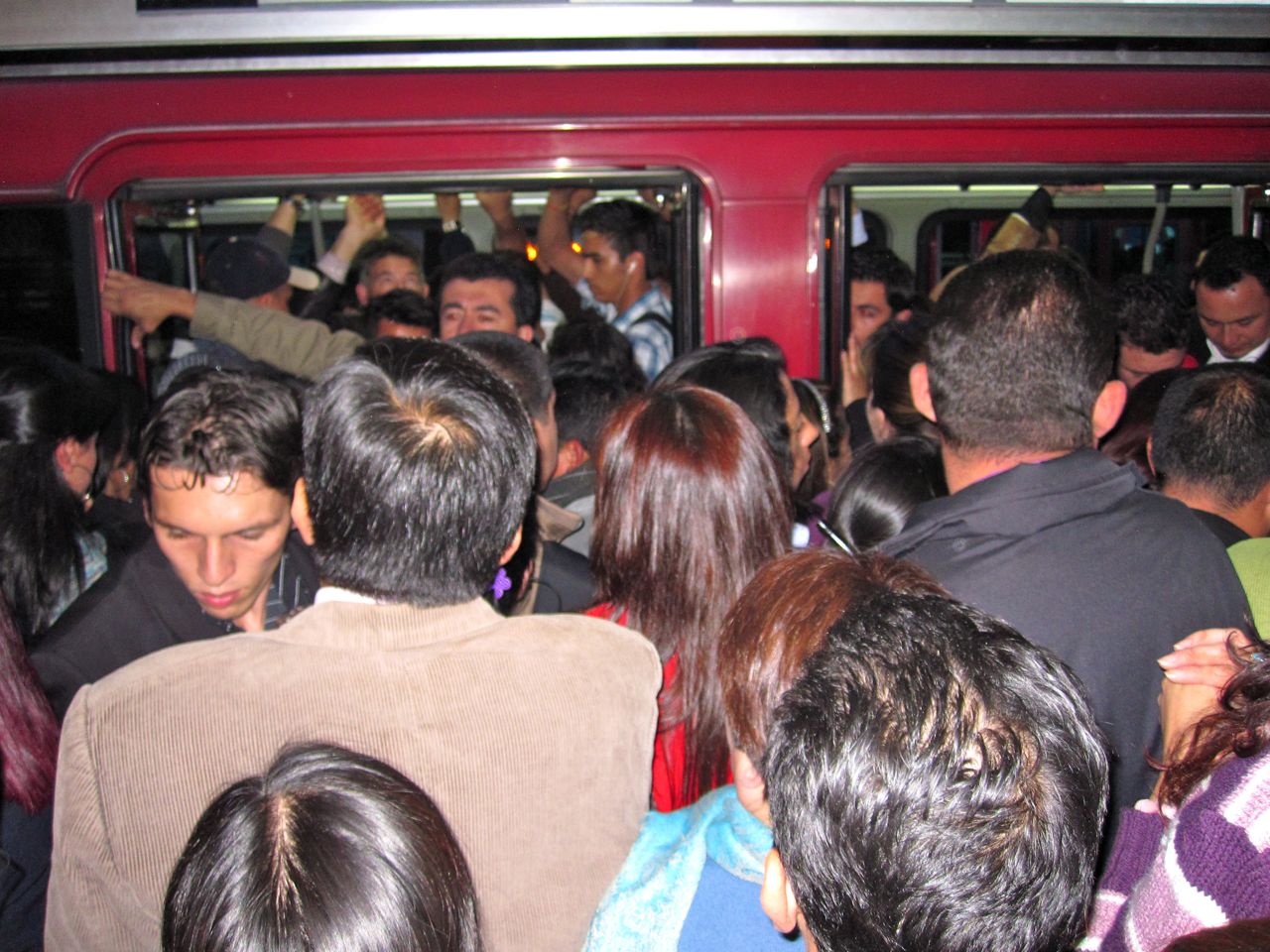
TransMilenio’s 76 Street station during rush hour
To secure these impressive benefits, the SITP will entail some trade-offs. The largest of these is increased occupancy in buses. As shown above, many collective public buses run nearly empty, even at rush hour. At the other end of the spectrum, the buses of TransMilenio are packed beyond capacity. Last year’s bus strike in Bogotá was notable for the extreme crowding and long lines to board TransMilenio. However, the photo below, taken on a normal weekday evening, is strikingly similar to this view of the same station on the day of the strike.
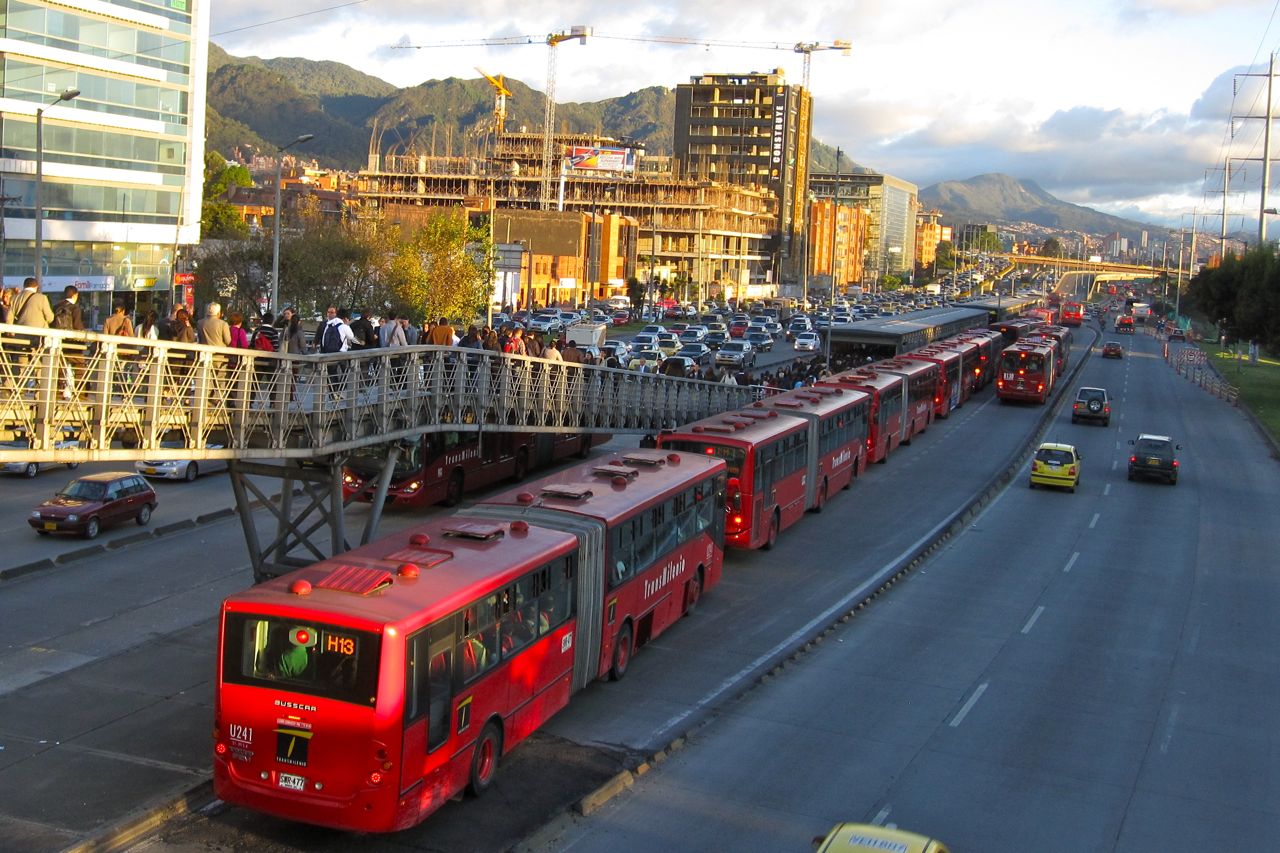
TransMilenio’s 100 Street station during rush hour
According to an annual survey by Bogotá Cómo Vamos, dissatisfaction with TransMilenio has been steadily increasing; this is largely due to crowding. As of 2010, users reported higher levels of satisfaction with collective public transport than with TransMilenio. Whether SITP alleviates crowding on TransMilenio with improved service in the rest of the city or increases crowding on collective public transport to the same level remains to be seen. Hopefully, SITP will successfully strike a balance between efficiency and comfort.
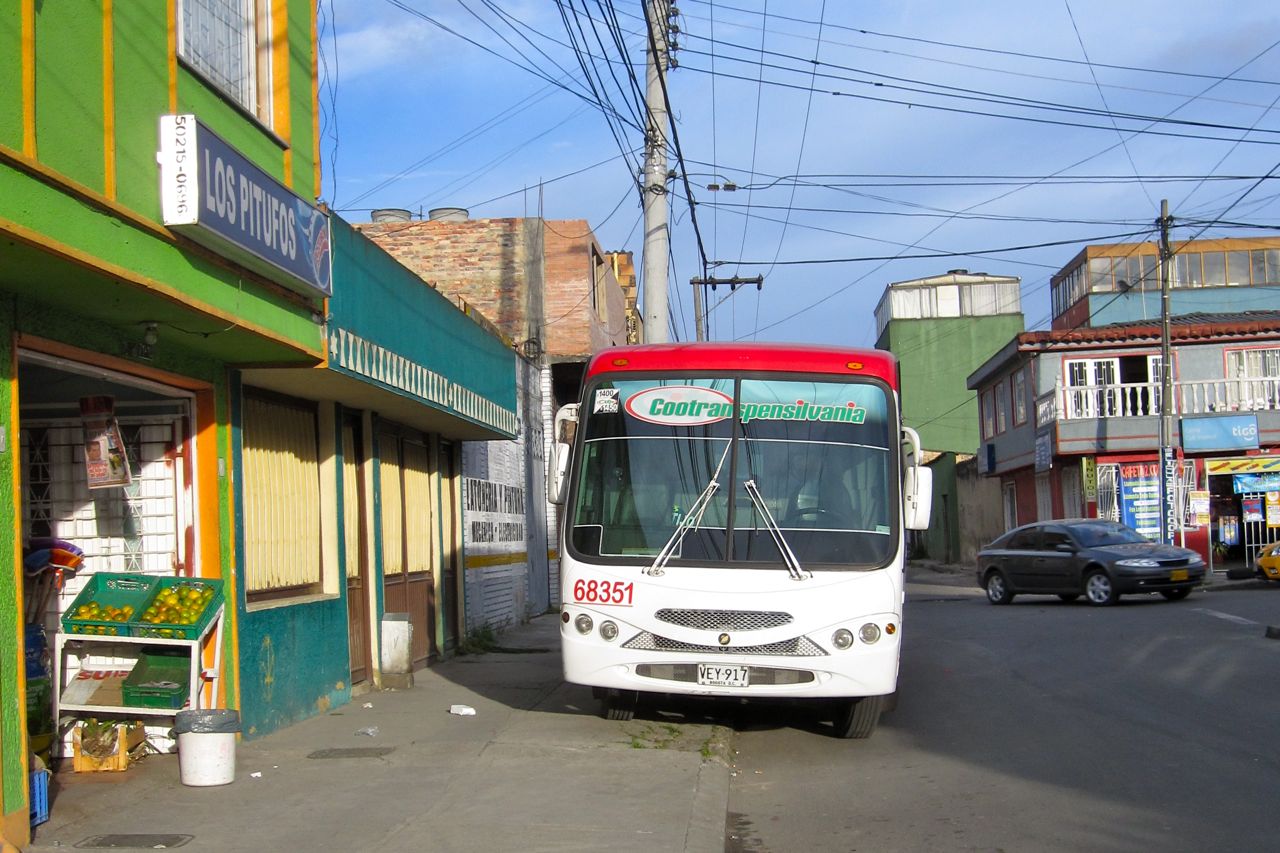
A collective public bus parked on a city sidewalk
SITP will transform Bogotá in more subtle ways, as well. For example, with the construction of formal bus depots, public space currently used for bus parking will be returned to city residents. Less aggressive driving and buses in better repair may improve the comfort of the ride. Bus operators will be held contractually responsible for maintaining adequate results on user satisfaction surveys; the link of these surveys to compensation will strengthen accountability for quality of service. Finally, many hope that the SITP will usher in a more humane era of what Carlos Cordoba, former director of Bogotá Cómo Vamos, calls “dignified public transportation.” While many things are still uncertain, one thing is for sure: after SITP, Bogotá will never be the same.
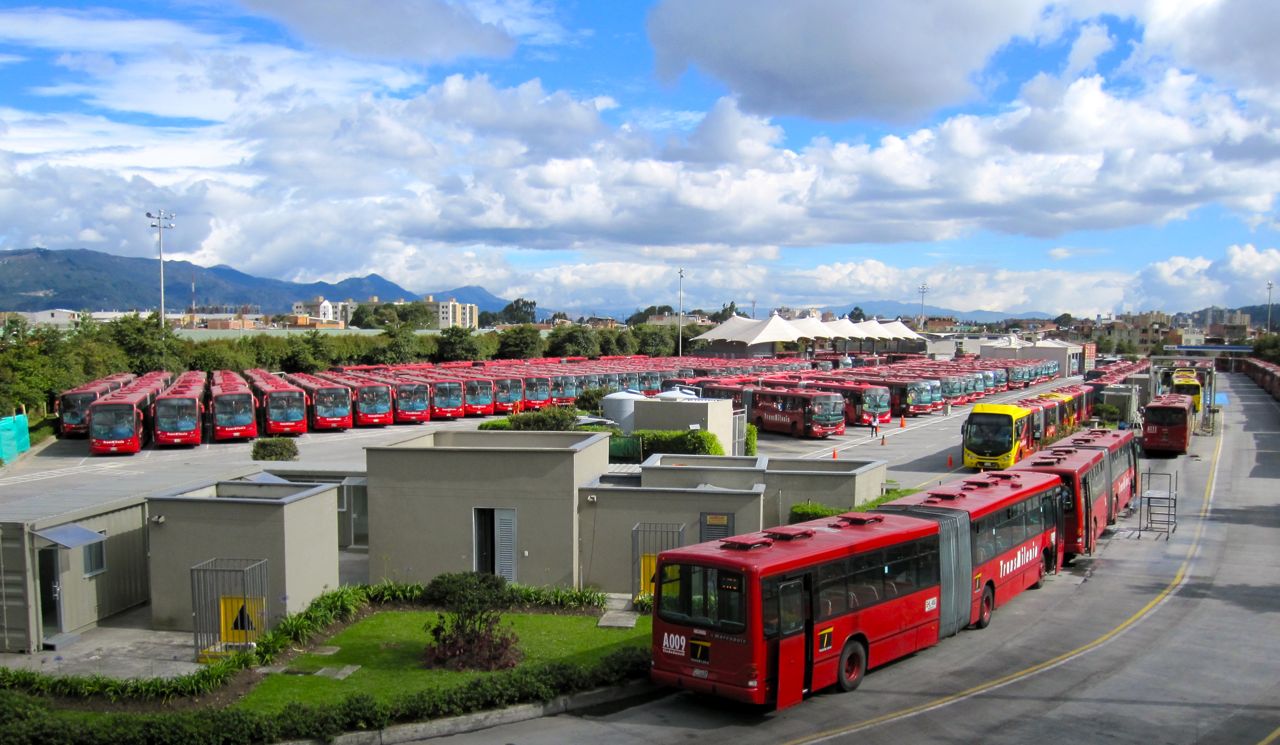
A TransMilenio bus depot near Portal del Norte
¿Comments? ¿Opinions? ¿Similar News? Send them to us!
Tweet
Nigel Wilson as Keynote Speaker in XV Congreso Chileno de Ingeniería de Transporte

The Chilean Conference on Transport Engineering (Congreso Chileno de Ingeniería de Transporte) is the main activity of the Chilean Transport Engineering Society (Sociedad Chilena de Ingeniería de Transporte – SOCHITRAN).
Nigel Wilson was invited as keynote speaker in this relevant event, and he presented the following topic: «The Role of Information Technology in Improving Transit Systems». You can download the presentation here. The other keynote speaker was the Chilean Transport Minister, Pedro Pablo Errázuriz, who Nigel had previously met in another meeting.
¿Comments? ¿Opinions? ¿Similar News? Send them to us!
Tweet
Rio de Janeiro's Transoeste BRT Corridor Still On Schedule

First 32 kilometers to be partially operational by May 2012
Source: EMBARQ
Photo by Prefeitura do Rio, Transoeste under construction
 EMBARQ Brasil performed a one-day roadmap framing workshop to promote knowledge and get commitment among the stakeholders involved in implementing the first bus rapid transit (BRT) corridor in Rio de Janeiro, known as Transoeste («Transwest.»)
EMBARQ Brasil performed a one-day roadmap framing workshop to promote knowledge and get commitment among the stakeholders involved in implementing the first bus rapid transit (BRT) corridor in Rio de Janeiro, known as Transoeste («Transwest.»)
The roadmap framing workshop convened 21 people who discussed the project’s risks and mitigation actions, created the opportunity statement, and developed the timeline of the project.
By May 2012, the first phase of the Transoeste corridor (32 kilometers) is scheduled to be operational, and by 2013, the 56 kilometers should be completely operational.
The Transoeste corridor will link the area of Barra da Tijuca with the districts of Santa Cruz and Campo Grande. When it is completed, the corridor will measure 56 kilometers long, with 53 stations. The high-performance BRT system is expected to reduce travel time by half between the districts it serves, which are located in the West Zone of Rio de Janeiro.
The roadmap framing workshop was held in the auditorium of the Municipal Secretariat for Transport, with the participation of the technical team, operators and project managers. Luis Antonio Lindau, director of EMBARQ Brasil, led the event, with the support of Daniela Facchini, project and operational director, both members of our CoE.
¿Comments? ¿Opinions? ¿Similar News? Send them to us!
Tweet
Improving Lima's public transport (in Spanish)

Source: SIBRT
Un futuro limpio, ordenado y amigable con el medio ambiente es el que la Municipalidad Metropolitana de Lima impulsa para la capital peruana a partir de enero de 2013.
Un futuro limpio, ordenado y amigable con el medio ambiente es el que la Municipalidad Metropolitana de Lima impulsa para la capital peruana a partir de enero de 2013, a través de la ordenanza municipal Nº 1538 que establece, entre otras cosas, la circulación del denominado ‘Bus Patrón’ como vehículo de transporte público.
Con estas unidades, se contará con un mejor servicio de transporte público, pues estas unidades deberán caracterizarse por el respeto, la comodidad y calidad para los ciudadanos. Así lo anunció la alcaldesa de Lima, Susana Villarán durante la exposición del ‘Bus Patrón’ realizado en la Plaza de Armas el pasado 22 de julio.
“Estos buses son fruto del esfuerzo de empresarios y propietarios del transporte para modernizar el parque automotor destinado al transporte público. Estos autobuses son el fruto del trabajo de cientos y miles de transportistas” precisó la alcaldesa.
Anunció que Lima contará con estos buses que circularán a través de los corredores o vías que construirá la comuna limeña y que confluirán en un “Sistema Integrado de Transporte”, que trasladará al 40% de los pasajeros de Lima con los estándares de rapidez, comodidad, orden y limpieza que todos los limeños y limeñas necesitan, además que hará posible que los pasajeros hagan todas las conexiones que necesitan para llegar a su destino con un solo boleto/pasaje/ticket.
Características del ‘Bus Patrón’
 La burgomaestre explicó las óptimas características de este tipo de vehículos, como por ejemplo un mayor tamaño físico y una mayor capacidad para transportar a pasajeros. En este caso, la ordenanza considera cinco tipos de vehículos, con longitudes de 9, 12, 14, 18 y 24 metros (los dos últimos son buses articulados) que transportan en 40, 100, 120, 160 y 240 personas, respectivamente.
La burgomaestre explicó las óptimas características de este tipo de vehículos, como por ejemplo un mayor tamaño físico y una mayor capacidad para transportar a pasajeros. En este caso, la ordenanza considera cinco tipos de vehículos, con longitudes de 9, 12, 14, 18 y 24 metros (los dos últimos son buses articulados) que transportan en 40, 100, 120, 160 y 240 personas, respectivamente.
Estos buses reducen la contaminación ambiental, toda vez que utilizan la normativa Euro 4, que reduce 50 veces la emisión de gases nocivos, tanto para motores a gas como para motores diesel. Asimismo, es un vehículo inclusivo porque favorece el transporte de personas con discapacidad.
Otro aspecto importante de destacar es que reduce la contaminación acústica, pues produce menos ruido debido al tratamiento de la carrocería aislante.
La alcaldesa de Lima, refirió que estos buses patrón o Euro 4 ya están siendo fabricados y/o ensamblados en el país.
La puesta en marcha de estas unidades de transporte no incrementará -de manera alguna- el costo de los pasajes toda vez que estos buses cuentan con la capacidad suficiente para albergar al número de pasajeros que requieren para cubrir sus costos de operación.
Sin embargo, este proceso de cambio será gradual para no afectar a los transportistas que vienen laborando en la ciudad, por lo que Villarán señaló que los buses Euro 3 seguirán circulando por vías seleccionadas de la ciudad hasta que recuperen su inversión y luego puedan adquirir los buses Euro 4 exigidos por la comuna limeña.
Los corredores complementarios a los que se refiere la autoridad edil son los de la Panamericana Norte – Sur, Javier Prado – Faucett, Tacna – Mercado de Flores y el de Independencia. En ese sentido, en el resto de rutas podrán seguir circulando buses Euro 3 y aquellos que han sido renovados.
¿Comments? ¿Opinions? ¿Similar News? Send them to us!
Tweet
Meeting with Chilean Transport Minister Pedro Pablo Errázuriz

Last week, our member Nigel Wilson visited Chile for Felipe Delgado’s PhD defense, and the opportunity was used to have a meeting with the Transport and Telecommunications Minister. The main topic was the fare mechanisms for Transantiago system. Nigel presented the state of the practice and the MIT experience in this subject, and later a conversation was started to analyze the future improvements in Santiago’s fare system. We expect to continue participating in the discussion of this and other related topics with our transport authorities. This is a picture of the participants of the meeting:
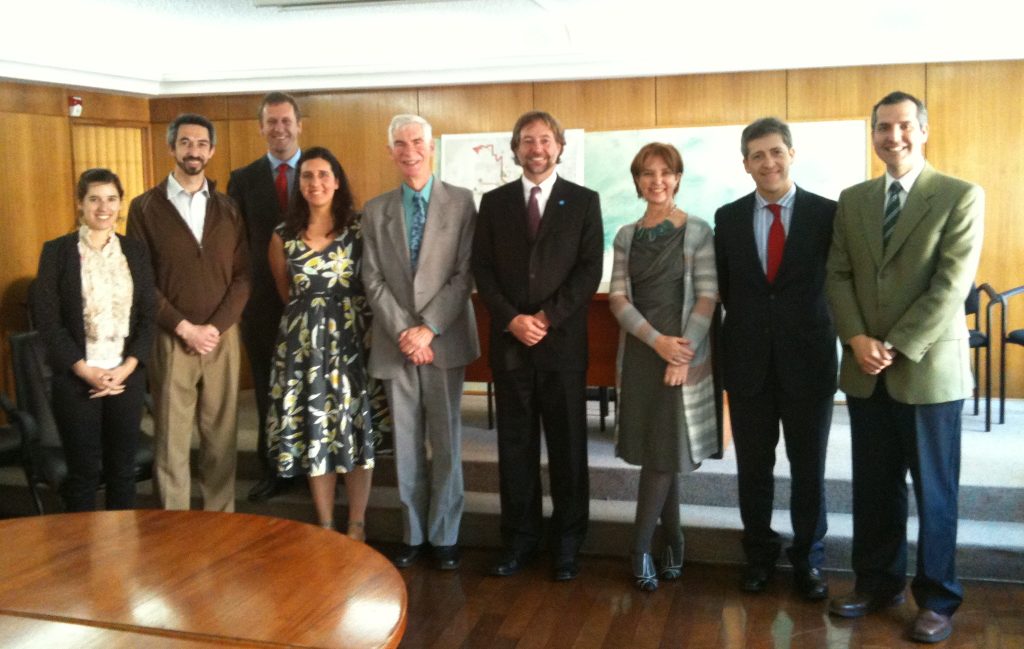
Ignacia Torres, Marco Batarce, Juan Carlos Muñoz, Patricia Galilea, Nigel Wilson, Minister of Transport of Chile Pedro Pablo Errázuriz, Undersecretary of Transport of Chile Gloria Hutt, General Manager of Transantiago Patricio Pérez and Ricardo Giesen.
You can download Nigel Wilson’s presentation here.
¿Comments? ¿Opinions? ¿Similar News? Send them to us!
Tweet
Opinion Pieces: The economy wide benefits of public transport infrastructure investment – time to look outside the transport box

Opinion Pieces: since 2007, Prof. David Hensher has written an opinion column in the Australasian Bus and Coach magazine, where he monthly discusses a lot of different transport-related hot topics. In this section we are revisiting these columns.
February 2011
The transport sector faces many challenges, given its critical role in the provision of mobility services. In recent years a number of researchers have argued that there are an increasing number of benefits associated with public transport projects that go beyond the identification of benefits to public transport users and the transport sector in general. These benefits have become known as the wider economy benefits (WEBs) and define a new set of benefits attributable to some market responses that follow public transport infrastructure investments. The inclusion of these wider economic benefits in appraisal of transport projects will help to ensure that we do not miss key investment opportunities for enhancing productivity. It is therefore important that we incorporate the best information we have to include wider economic benefits in transport appraisal. The key WEBs are: (i) Agglomeration – bringing activities closer together is time and space, partly linked to the redistribution of employment opportunities and gains in productivity in the provision of goods and services from spatial concentration, (ii) Increased output in imperfectly competitive markets, and (iii) Labour market impacts – labour supply and the move to more productive jobs.
Firms and workers deciding where to work and live trade off various benefits and costs (wages, rents, congestion etc.). Their final location decision will be a contributing factor to the overall city size. When each firm or worker takes a location decision they consider the benefit to themselves such as the impact on profit or wage but (in most cases) do not consider the impact of their decisions on the productivity of others. A firm or worker’s location decision may generate agglomeration economies, which benefit not only the individual firm but also other firms and workers located in the cluster. There is therefore an ‘externality’ in addition to the private benefit.
The rearranging of activities in time and space also delivers improvements in levels of air pollution and emissions in general. Why might the transport sector care about this? There are obvious reasons, one most important one being that if we can identify a larger number of benefits associated with investment in public transport, then the transport portfolio of government can present a stronger case to Treasuries (State and Federal) of the value of public transport projects. While there are claims that such additional economy wide benefits can be as high as 60 percent on top of the traditional transport-sector modelled benefits (mainly gains in travel time), benefits associated with agglomeration look like delivering up to an additional 10-20 percent of benefits, an amount not to be ignored.
The identification and inclusion of these WEBs means that we can provide additional information to help inform prioritization of schemes for funding allocation. With higher returns to public transport projects, we could release more public funds for investment, as well as identify the impacts on gross domestic product (GDP) which always interests governments, and can help to support call for private participation in infrastructure investment.
Food for thought
¿Comments? ¿Opinions? ¿Similar News? Send them to us!
Tweet
Transmetro from Barranquilla is the Colombian transit system with lowest accident risk index (in Spanish)

Source: SIBRT
Según evaluación del Fondo Nacional de Prevención Vial el índice de Transmetro es del 23,4% y está por debajo del índice nacional que es del 26%.
Transmetro es el Sistema con el índice global de riesgo en la operación más bajo de Colombia, con un 23.4%, por debajo del promedio nacional, que registra un 26%. Este es uno de los resultados más importantes de la evaluación que realizó el Fondo Nacional de Prevención Vial y que fueron dados a conocer hoy por su Directora Ejecutiva, la Dra. Alexandra Rojas, en reunión con el Gerente de Transmetro, Manuel Fernández.
El informe destaca que gracias a su política preventiva, Transmetro ha tomado medidas y controles para disminuir hasta un punto razonable la probabilidad de ocurrencia de incidentes de seguridad en la operación, por lo cual el FNPV considera que el Sistema ha tenido un alto impacto en los resultados de seguridad vial de Barranquilla, que mostró una disminución del 60% en el número de muertes en accidentes entre el 2006 y el 2010, según un estudio del Fondo.
La evaluación enfatiza que Transmetro es el sistema de Colombia que mejor gestiona y controla la operación de las rutas alimentadoras y que cuenta con buses en buenas condiciones y con los equipos de seguridad necesarios. El informe también destaca las buenas prácticas de Transmetro en cuanto a la formación integral de los operadores del Sistema y del equipo de atención al cliente, especialmente en relación con la atención a la población discapacitada.
La evaluación se realizó hace tres meses mediante la aplicación de un instrumento con 131 preguntas, en los temas: Infraestructura, institucionalidad, talento humano, equipo móvil y equipamiento estático. El Fondo Nacional de Prevención Vial planteó la elaboración de un plan de acompañamiento a Transmetro con el que se busca el mejoramiento continuo del Sistema.
¿Comments? ¿Opinions? ¿Similar News? Send them to us!
Tweet
85% of Canadian drivers have never used transit

Source: CBC News
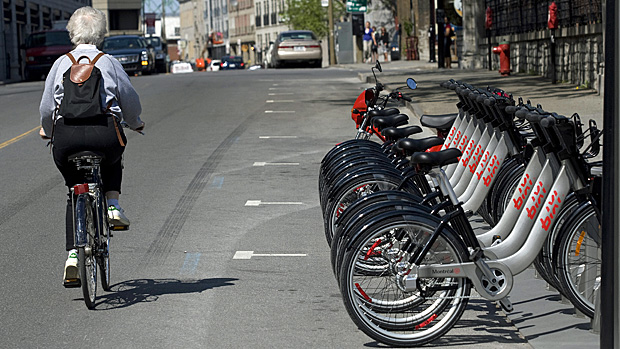 The vast majority of Canadians who drive every day have never attempted any other way of getting to work, according to a new survey published in August on the typical commute last year.
The vast majority of Canadians who drive every day have never attempted any other way of getting to work, according to a new survey published in August on the typical commute last year.
The survey by Statistics Canada found that 82 per cent of Canadian workers drive to work, 12 per cent take some sort of public transit, while six per cent walk or bike to work.
Of the 10.6 million workers who commuted by car, 15 per cent, or 1.6 million, had tried using public transit to get to work. But nine million had never tried any other way of getting to work.
A vast majority of drivers said their main reason for not trying anything else was because it would be inconvenient.
Cyclists, walkers fare better
As it turns out, they may be on to something: the survey also showed that transit users have longer than average commutes.
- The average Canadian commute to work was 26 minutes in 2010, the data showed.
- Those who walk or bike to work had the shortest commute, on average, at 14 minutes.
- Although there’s wide disparity, drivers could expect a 24-minute commute, on average.
- But those who rely on public transit took an average of 44 minutes to get to work every day — almost triple the amount of time it takes walkers and cyclists, and nearly double what drivers do.
Transit users who live outside of large urban centres fared even worse. It takes them an average of 51 minutes to get to work every day, compared to 36 for their big city counterparts.
Longer commutes had a correlation with stress levels and overall happiness, the survey found. But there are economic consequences too.
«The longer you spend driving in traffic (over an hour a day in Toronto) clearly means more personal household spending on gasoline, leaving less discretionary cash,» ATB Financial economist Todd Hirsch said in reaction to the report. »
As well, labour market productivity on the job could be affected if workers have to spend a great deal of time getting to-and-from work. Improved public transportation systems … in the coming years could help reduce congestion and commute times.»
Perhaps not surprisingly, average commute times overall are higher if the city is larger. Here are the cities with the longest average commute times in Canada:
- Toronto: 33 minutes
- Montreal: 31
- Vancouver: 30
- Ottawa: 27
- Calgary: 26
- Edmonton: 23
Across the country, 20 per cent of commuters of all stripes reported being in some sort of traffic jam on their way to work on a daily basis. But more than half reported they never experience traffic.
¿Comments? ¿Opinions? ¿Similar News? Send them to us!
Tweet
Straight from the Source: What services should you operate in a bus corridor? And what can we achieve in time savings, reliability, and comfort if properly controlled?

Source: Volpe
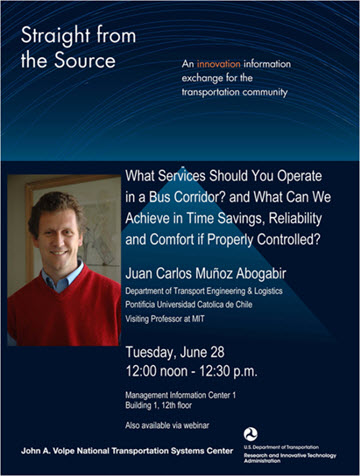
The Volpe Center is part of the U.S. Department of Transportation’s Research and Innovative Technology Administration and is an innovative, Federal, fee-for service organization. Their mission is to improve the USA’s transportation system. Their work is performed for U.S. DOT, as well as other Federal, state, local, and international agencies and entities.
Straight from the Source: This engaging speaker series enables an information exchange between the transportation community and today’s leaders in transportation. Straight from the Source events are held at the Volpe Center in Cambridge, Massachusetts and are also accessible via webinar.
Juan Carlos Muñoz presented on June 28 a seminar in the Straight from the Source series called «What Services Should You Operate in a Bus Corridor? And What Can We Achieve in Time Savings, Reliability, and Comfort if Properly Controlled?»
Watch the video presentation here.
¿Comments? ¿Opinions? ¿Similar News? Send them to us!
Tweet
New plan works for transit, communities

Source: Editorial at The Chicago Sun-Times
Chicagoans over the years have concocted one pie-in-the-sky scheme after another to connect the city’s famously unconnected L system.
Snazzy names like the “Circle Line” and the “Central Area Circulator” rolled off officials’ tongues.
Then nothing.
Finally, a plan being released today may break that pattern of dream and bust. For less money and a bigger potential return on investment for city neighborhoods, we’re betting on a nearly 100-mile “Bus Rapid Transit” network proposed by the Metropolitan Planning Council.
In an analysis released Wednesday, the regional planning group envisions 10 dedicated bus lanes that would connect riders to L and Metra trains, speed up existing bus trips, improve transit choices in underserved areas and spur or enhance community development.
Buses traveling in these lanes — on such streets as Western Avenue, Garfield Boulevard and Irving Park Road — would go twice as fast as existing buses, run every 5 to 10 minutes, stop every half mile at pre-pay stations and get traffic signal priority. Any regular bus rider would say hallelujah to that.
But MPC’s plan isn’t only about moving riders more quickly; it’s also about making better neighborhoods. In selecting routes, MPC devised a formula that weighed access, or lack thereof, to retail, jobs, schools and other community anchors, as well as proximity to rail lines and existing travel times and ridership. Dedicated bus lanes can enhance thriving communities and, hopefully, give a boost to areas in need.
Dedicated bus lanes have downsides. Drivers lose a lane on key thoroughfares, invariably decreasing traffic speed. And some business owners will balk as buses speed by without stopping. Long term, these lanes will hopefully help reduce traffic congestion by getting drivers onto buses.
And while far cheaper than adding new rail lines, creating the bus lanes would cost money. The average U.S. per mile cost is $13.3 million, though MPC predicts lower costs given Chicago’s flat landscape.
But the beauty of the MPC’s proposed rapid bus transit system is that one line could be built at a time. That way, individual communities will benefit — and Chicago can test, refine and render a verdict on dedicated lanes.
The CTA already is taking that approach, with work under way on Jeffery Boulevard. The CTA also is planning for a Western Avenue lane and a route from Michigan Avenue to the train stations in the West Loop.
Mayor Rahm Emanuel is a big fan of dedicated bus lanes, committing to them in his transition plan, as is his transportation commissioner and his CTA chief.
It’s time to move beyond pie-in-the-sky and build a better-connected Chicago.
¿Comments? ¿Opinions? ¿Similar News? Send them to us!
Tweet
Guangzhou BRT Reduces CO2 Emissions by 86,000 Tonnes Annually

Source: ITDP
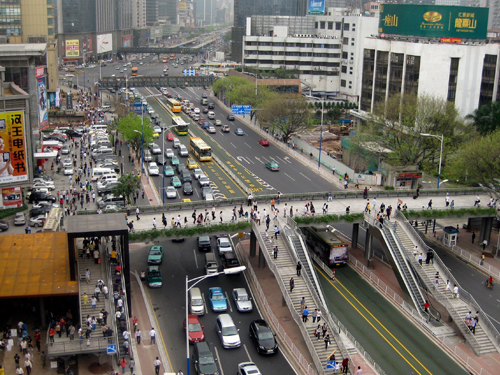 System has also vastly improved travel speeds for motorists and bus riders alike
System has also vastly improved travel speeds for motorists and bus riders alike
Guangzhou, China opened its first, 22.5-kilometer Bus Rapid Transit corridor in 2010 in an effort to cut congestion on one of the city’s busiest roads, Zhongshan Avenue, and to improve the efficiency of the city’s bus system. The Institute for Transportation and Development Policy issued preliminary findings from a new study showing the Guangzhou BRT has done this and more.
Key findings of the study include:
– Travel times have improved for motorists and bus riders along the corridor 20% and 29% respectively.
– The system now has 805,000 daily boardings. It is carrying more passengers per hour than any metro line in mainland China outside of Beijing, and more than triples the capacity limits achieved with any other BRT system in Asia.
– The system will reduce Guangzhou’s CO2 emissions by 86,000 tonnes annually, mostly through improved bus operations efficiency.
– The project includes a new greenway parallel to the BRT corridor and a 5,000 bike public bike share system. Bicycle ridership is up approximately 50% since the corridor opened.
Karl Fjellstrom, Vice Director of ITDP says, “The Guangzhou BRT system expands the menu of options available to mayors seeking high quality transit systems to address congestion, showing that BRT can meet the needs of even the highest demand corridors in the largest cities. The project has been a huge success with the public, increasing satisfaction with public transport in Guangzhou from 29% to 65% since the project opened.”
With rapid increases in wages and standard of living, private vehicle ownership in Guangzhou has increased 22% annually over the past five years (over 310,000 new cars in 2010 alone). Still nearly half of residents, or over 7 million people rely on mass transit. This project helps meet this high demand and maintains transit as an attractive option. It also serves as a model for other cities throughout China and around the globe, of a high-quality, cost-efficient transit solution.
The study is available online here. This is the first part of a longer-term monitoring and evaluation program for the Guangzhou BRT. It focuses primarily on the system’s impacts on CO2 and air pollution.
¿Comments? ¿Opinions? ¿Similar News? Send them to us!
Tweet
BRT projects for Monterrey, Mexico (in Spanish)

Source: Milenio
El secretario de Obras Públicas, Luis Marroquín, anunció el arranque del proyecto que contempla carriles exclusivos para el paso de trenes ligeros o BRT.
Monterrey – A las obras federales, estatales y municipales en proceso, que generan un gran caos vehicular, se sumarán a partir del próximo lunes los trabajos de construcción de la Ecovía, sobre las avenidas Lincoln y Ruiz Cortines.
En reunión con integrantes de la Cámara Nacional de Comercio de Monterrey, el secretario de Obras Públicas, Luis Marroquín, anunció el arranque del proyecto que contempla carriles exclusivos para el paso de trenes ligeros o BRT.
La primera etapa, detalló el funcionario, incluye la construcción de once kilómetros, de un total de 30, que ya fueron licitadas por la dependencia estatal en las semanas previas.
«Estos primeros 11 kilómetros debemos de estarlos terminando por ahí de marzo del próximo año, ese es el período de ejecución, ojalá lo podamos hacer antes, pero también hay que tomar en cuenta que tenemos obstrucciones en líneas de servicio, que nos pueden llevar el primer mes en la reubicación de todo eso y ahora sí ya después vamos a ver cómo podemos entrarle con todo».
Marroquín dijo que la segunda y última etapa iniciará en un período de dos meses y medio, para concluir los 19 kilómetros restantes del proyecto, cuya inversión no fue precisada por el funcionario estatal.
Lo que sí estimó es que los trabajos deberán estar listos para el mes de mayo del próximo año, de acuerdo al calendario de obra trazado.
«Bueno, las etapas han venido dándose de acuerdo a la disposición de los recursos, en este caso el primer recurso de Banobras fue, es eso, estamos trabajando ya en la segunda etapa, en la aprobación de la publicación de la convocatoria, que se hará próximamente, para los 19 kilómetros restantes».
Durante su exposición ante los miembros de Canaco, el secretario de Obras Públicas explicó que también se contempla un sistema de transporte similar a futuro en Morones Prieto y Constitución.
Revise más detalles del projecto en la siguiente página web.
¿Comments? ¿Opinions? ¿Similar News? Send them to us!
Tweet
Alert warning system planned for Metrobus in Washington

Source: The Washington Examiner
Metrobus riders soon will be able to get electronic warnings about delays to their bus trips similar to the ones rail riders already receive, according to the transit agency.
Metro is hiring a three-person team to add to its communications staff for the sole purpose of sending alerts to riders about bus service problems, spokesman Dan Stessel told The Washington Examiner. The team will work out of the agency’s bus operations control center in Prince George’s County, sitting alongside dispatchers and cameras to find out what is happening with the hundreds of buses out on the road.
The staff will send out email alerts about major disruptions such as motorcades, nasty traffic jams and the like that keep buses from getting where they are supposed to go.
«The thinking is that customers will be able to sign up for their bus service by line or lines,» Stessel said.
The push comes as Metro tries to make riding the bus more appealing to take the pressure off the rail system. It also has been trying to improve its communication with riders systemwide, a sore spot for years.
Currently rail riders can sign up to receive e-alerts that let them know about delays along the train lines they ride. Recently, the agency rolled out an elevator alert system, as well, so riders who need to use the elevators can better plan their trips.
But so far bus riders have been left out. It’s a far more complicated system in some ways as Metro has more than 1,200 buses on the roads during the daily rush.
In July 2009, Metro created the NextBus system that uses GPS technology to predict when the next bus is coming. But that system cannot take into account disruptions along the line, nor does it reach out to riders directly.
The new bus alert service will be active only on weekdays to start, Stessel said. But the staffers will be on-call at other times to post alerts for major disruptions, he said.
Stessel said the agency has posted the jobs listings and has received resumes. They hope to have it up and running by the end of the year, he said.
¿Comments? ¿Opinions? ¿Similar News? Send them to us!
Tweet
Chennai: Hopes about BRTS still persist

Source: The Hindu
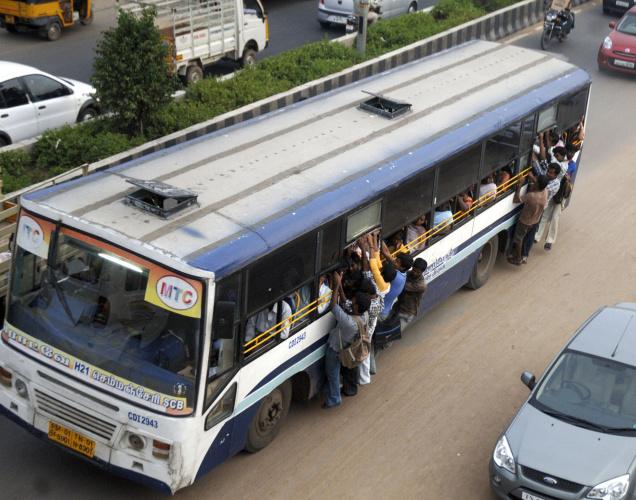 Inadequate?: An overcrowded bus on Rajiv Gandhi Salai where a dedicated bus lane is being proposed.
Inadequate?: An overcrowded bus on Rajiv Gandhi Salai where a dedicated bus lane is being proposed.
Where will Chennai, India figure if its public transport bus system is compared with other large metropolitan cities? The sad truth is: somewhere at the bottom of the pile. The Metropolitan Transport Corporation’s (MTC) operational fleet of 3,000 buses is one of the lowest among any major metropolis in the country. The comparison with Delhi’s fleet of 8,000 or Bangalore’s 6,100 buses is even more telling because both the cities transport fewer passengers every day than Chennai.
Most major city bus services in the country account for a ridership of 40 to 50 lakh passengers a day. The MTC carries 56 lakh passengers a day with less than half the number of buses as other cities. Overcrowding during rush hour is rampant.
Since its days of glory in the 1980s when the then Pallavan Transport Corporation was considered one of the best in the country, public transport in the city has taken a major hit due to persistent neglect, say experts. One attempt to reverse this trend in favour of public transport is the Bus Rapid Transit System (BRTS) proposal which is under the consideration of the government. The move is long overdue. Surveys to build dedicated bus lanes were undertaken in 1967, 1975 and as recently as 2009. Every time, private vehicle traffic was given preference and diverting a lane exclusively for buses was found unfeasible. This, despite the fact that MTC buses transport over 50 per cent of the passenger volumes on major arterial roads.
“There is an element of social equity involved when deciding who gets to use the city’s road space,” says Shreya Gadepalli of the Ahmedabad-based Institute for Transportation and Development Policy (ITDP). MTC buses plying through both Anna Salai and Grand Southern Trunk Road have a carrying capacity of about 11,000 passengers per hour per directional (pphpd), which, interestingly, is almost the same as a monorail corridor. “The BRT being proposed on Rajiv Gandhi Salai will have a capacity of 14,000 pphpd,” says Ms.Gadepalli.
Buses can shuttle through the proposed corridor at 25-30 kmph, instead of the current average speed of 6 kmph.
The amount of overcrowding and delay due to congestion will soon become too much to even sustain bus operation in Chennai, says Sudhir Badami, an urban transportation expert and a member of the Mumbai BRTS technical advisory committee.
“Studies show that bus passengers get exhausted by the amount of crowding as well as side sways and lateral forces even for a 2-3 km journey. Why should the majority of people suffer just because a few people can go in cars? It is the duty of the government to ensure equitable living standards and a respectable, dignified life for everyone,” Mr.Badami adds.
Insisting that no amount of road building can accommodate the vehicle growth rate that the city is going through, R.Balasubramanian, a former Managing Director of MTC, said “Proposals for a dedicated bus corridor on OMR were made way back in 2006. But we never do things until it has become too late. Our city planners have largely failed to provide residents a better quality of life.”
¿Comments? ¿Opinions? ¿Similar News? Send them to us!
Tweet
Opinion Pieces: On public transport investment and fair payment for road use

Opinion Pieces: since 2007, Prof. David Hensher has written an opinion column in the Australasian Bus and Coach magazine, where he monthly discusses a lot of different transport-related hot topics. In this section we are revisiting these columns.
January 2011
Language and words are powerful ways of communicating simple but important points of view. If we could agree on the meaning of sentences then we will be making great progress in communicating the points of relevance in contrast to the points of misleading commentary. Let me illustrate this. In the debate between light rail (LRT) and bus rapid transit (BRT), supporters of LRT are often heard to say that LRT can carry far more people than BRT per hour, and when we drill down to get clarity they really mean that LRT can carry more people per carriage (or carriage set) than a bus or BRT. When it is pointed out that trunk capacity per vehicle is not the issue but service capacity per hour, and that much more bus service capacity can be delivered per hour than LRT service capacity (in addition to flexibility in service in connecting with feeders), there is a glazing over of the LRT eyes. Simple point – talk service capacity per unit of time, not vehicle capacity.
Another example, laden with emotion, is the reference to road pricing and especially the variant correctly called congestion charging. Immediately this is mentioned, the uninformed respondent refers to a congestion tax and assumes it is added onto all existing taxes. There is little hope to sell the merits of reformed road pricing when the word ‘tax’ hits page one of the media every time we try and have a sensible debate on the need to change the current charging scheme (namely fixed registration charges and fuel excise). A careful listening to what we are trying to say to educate the population is that we need to do something to contain traffic congestion, and that we have a real opportunity to review existing charging mechanisms and to align charging closer to the costs that users impose on the network through using their cars and trucks and buses (in contrast to owning their cars and trucks and buses), and that we should be able to design a pricing mechanism that is much fairer, but includes a way of charging for congestion that is contributed to by users of the road network. This would involve dropping some charges as we add in some new congestion-related charges and importantly show how the revenue raised is put back to useful causes that are supported by society. It is possible (yes – believe me) to design a system in which many users of the roads are financially better of with a congestion charge and even an emissions-related charge, where the cost of using the roads is lower when congestion is absent and vehicles are environmentally cleaner. Who would disagree with this? After all time is money although you would wonder sometimes when people complain about delays but will not support possible ways of aiding improved travel times. Few indeed I suspect; however until we can get away from the clutter of emotional misleading language like ‘being slugged with a congestion tax’, what hope is there. The media in particular needs to be more responsible.
Food for thought
¿Comments? ¿Opinions? ¿Similar News? Send them to us!
Tweet
Amman Bus Rapid Transit Project Faces Delays

Source: The City Fix
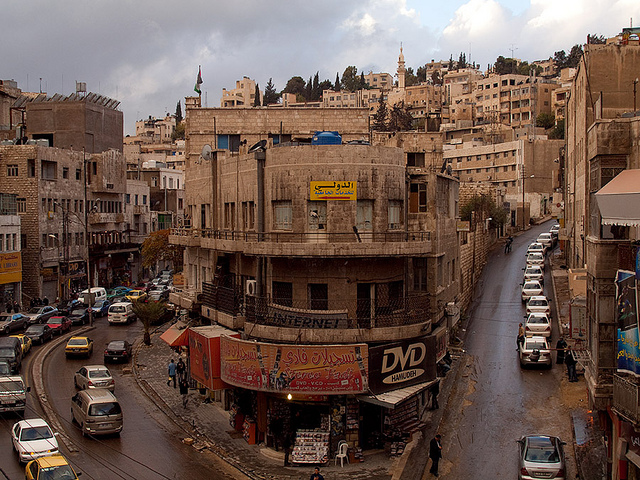
The Greater Amman Municipality (GAM) may no longer be pursuing a bus rapid transit (BRT) system because of opposition from within government circles, according to anonymous sources interviewed for an article in the Jordan Times. The major transport project has received a positive assessment from a government-appointed review committee, but recently the committee has faced “political pressure” to drop the project altogether, another article reports.
The Greater Amman Municipality (GAM) may no longer be pursuing a bus rapid transit (BRT) system because of opposition from within government circles, according to anonymous sources interviewed for an article in the Jordan Times. The major transport project has received a positive assessment from a government-appointed review committee, but recently the committee has faced “political pressure” to drop the project altogether, another article reports.
The project was initially received with much anticipation. In a 2010 news article, Prime Minister Samir Rifai cited the BRT as an important step towards developing a comprehensive public transportation system in Amman and described the project as a “great achievement.”
Amman Mayor Omar Maani showed similar enthusiasm in the initial stages of the project. “The public transportation sector in Amman will see tangible progress in quality in the next four years,” Maani said in an interview with the Jordan Times. Maani added that the BRT will show improvements in the rehabilitation of sidewalks and car parking spaces.
The initial plans of the BRT called for three routes, totaling 32 kilometers (20 miles.) The BRT service was designed with premium, high-capacity buses running along Amman’s busiest corridors on exclusive and completely segregated lanes, each one carrying 120 passengers and running on three-minute intervals during rush hour.
GAM secured a $166 million loan from the French Development Agency to finance the BRT’s implementation, and construction began last year. According to an anonymous source from the GAM, the project faces opposition because of fears that the BRT will add to the existing financial burden of the municipality.
GAM’s budget for 2011 was approved to be JD406,556,000 (about US $573 million) with a deficit of JD11 million (about US $16 million). During the budget approval, GAM also adopted a financial policy to reduce the budget deficit to JD5 million (US $7 million).
When the Mayor of Amman reviewed this budget back in 2010, he accounted for the BRT project. The budget was also meant to focus on other projects that sustain and implement open and bright roads, enhance sanitation and preserve the environment.
The project was expected to be operational in 2012 with a capacity of 7,000 passengers per hour in each direction. The system was anticipated to have a major impact on reducing traffic congestion.
¿Comments? ¿Opinions? ¿Similar News? Send them to us!
Tweet
Transportation: The Rapid Expansion of Bus Rapid Transport

Source: Americas Quarterly by Dario Hidalgo
The concept of bus rapid transit (BRT) is not new, but in the past decade urban planners began to focus on it as a way of increasing transportation efficiency and getting cars off the road in highly congested cities. And they are increasingly turning to Latin America—the cradle of BRT— for ideas that work.
While there is no single definition for BRT, the systems generally involve dedicated and separate bus lanes, permanent stations similar to those of rail transportation, longer distances between stops, and the use of information technology to improve operational efficiency. The goal is to offer fast and low-cost urban mobility through a system that provides service approaching rail quality, but at a fraction of the cost to build and operate.
Curitiba, Brazil, became the first city in the world to implement dedicated bus lanes when 12 miles (19 kilometers) of service was introduced in 1974—an initiative upgraded to a fully functioning BRT in 1982.
Since then, 31 additional cities have launched BRT systems across Latin America, serving 17 million passengers daily. Systems include: El Trole in Quito, Ecuador (1995); TransMilenio in Bogotá, Colombia (2000); Metrobús in Mexico City, Mexico (2005); Metropolitano in Lima, Peru (2010); and Metrobús in Buenos Aires, Argentina (2011). Additional BRT operations are running in other cities in Brazil, Colombia, Ecuador, Mexico, Guatemala, Chile, Panama, and Venezuela.
The world has followed Latin America’s lead in BRT. As of January 2011, at least 118 cities globally—from Los Angeles to Istanbul to Guangzhou, China—have launched BRT systems, with 27 cities doing so in the past 10 years alone.
But while transportation planners increasingly look to BRT to reduce congestion, pollution and road fatalities at a time of reduced city budgets, its implementation in Latin American cities has not been without difficulties.
A Magic Bullet?
The main driver of BRT is its low price tag. Capital costs range from one-tenth to one-third of comparable rail systems. Systems also can be implemented in a short timeframe. For example, Macrobús in Guadalajara, Mexico, began operations in March 2009—just two years after the idea was proposed. Such quick turnaround makes these systems an attractive option for city mayors wishing to show results before the next election.
Across the region, BRT systems also get high marks for their performance. Bogotá moves 45,000 passengers per hour per direction at a speed of 16 miles (26 kilometers) per hour. Guayaquil boasts more than 13 passengers boarding its Metrovía buses per kilometer driven, and in Mexico City, 3,000 passengers ride each bus on an average day. High performance brings low operational costs.
BRTs also save time, emissions and accidents. For instance, with the implementation of TransMilenio, Bogotá enjoys an average commuter time savings of 31 percent. Add to that the 302,000-ton reduction in carbon dioxide per year and the 16 lives saved and 260 injuries prevented from road accidents. Similar results have been reported in other BRTs.
As the concept advances, interesting trends are emerging. BRTs can increasingly count on integrated citywide bus systems, improved processes for private-sector participation in operations, increased funding from national governments, and a rise in the number of bus manufacturers and technology providers. These changes are already being seen in countries like Brazil, Peru, Colombia, and Mexico.
New information systems that enhance bus quality and performance are also coming on line. For instance, passengers using select BRT systems are now able to plan their route online and to receive real-time information about bus arrivals on their cell phones. At the same time, global positioning systems and advanced control systems are improving system reliability.
But challenges remain for BRT implementation.
First, there is the political hurdle. A mayor needs to be firmly committed to the concept. Inevitably, detractors and opponents—some of them quite powerful politically and economically, such as private bus operators and car users—will emerge. In Quito, Santiago and Bogotá, private bus owners and operators—afraid they would be pushed out of their routes by the new systems—staged protests against the local BRT.
Bogotá car owners—organized by community and business groups—blocked the dedicated bus lanes in the Carrera Séptima BRT corridor to protest the reduction in traffic lanes available for private use. In every case, strong leadership in the mayor’s office and special provisions that allowed existing groups to be part of the new programs preempted opposition.
The second difficulty is institutional, both in the public and private sectors. The public sector needs to develop new institutions and attract a labor force to manage and work on these relatively complicated and technical systems. For its part, the private sector must develop formal companies with the capacity to retain and train drivers, mechanics and operational personnel.
Finally, cities need to find new revenue sources to support construction and maintenance of BRT infrastructure, such as transfers from state or national governments, new taxes, bonds or privatizations.
One key decision remains: should governments provide subsidies for students, the elderly and the poor so that they can use the more expensive BRT system? Santiago and São Paulo subsidize public transportation riders, including those who use the BRT. In Quito and Guayaquil the system offers discounted fares for students, elderly and the handicapped, using the revenue from their overall fare collections.
But subsidies largely remain out of the question, since systems typically operate on tight budgets that rely on the revenues generated by user fares.
Other issues seen in BRT systems across Latin America and other developing countries include lack of maintenance, insufficient user education, low quality of service, high occupancy levels, and safety and security concerns. These issues are mostly the result of institutional and financial constraints and are not intrinsic to the BRT concept.
But still, overcoming these issues is critical for the future of BRT systems and will only come with political leadership, adequate funding levels and good planning and management.
A Promising Future
BRT operations will continue to grow, with innovation and adaptation of existing models in cities around the world. But progressive policies and greater knowledge sharing are still needed to address present and future challenges.
One initiative, the Asociación Latinoamericana de Sistemas Integrados y BRT (SIBRT) established in 2010, provides a forum for agencies to share experiences on how to foster BRT system development. In addition, the Center of Excellence in BRT, a research institution established in Chile in 2010, seeks to advance best practices in BRT design and implementation.
These types of new forums offer an important space to address critical issues, such as high occupancy levels, which must be resolved for the BRT model to become an increasingly important transit alternative in a budget-constrained environment.
Urban areas must find new solutions to traffic. With the right tweaks to its BRT systems, Latin America can be a model for transportation planners.
¿Comments? ¿Opinions? ¿Similar News? Send them to us!
Tweet
Boxer, Feinstein Announce $9.7 Million for Bus Rapid Transit in Los Angeles

Source: Barbara Boxer, U.S. Senator website
Will create dedicated bus lanes along Wilshire Boulevard
Washington, D.C.—Senators Barbara Boxer and Dianne Feinstein both (D-CA) today announced a $9.7 million grant for Los Angeles County Metropolitan Transportation Authority to enhance bus rapid transit on Wilshire Boulevard in Los Angeles. This award was the result of funding that Senator Feinstein secured in the fiscal year 2009 Transportation, Housing and Urban Development, and Related Agencies Appropriations Act.
Senator Feinstein said, “This Bus Rapid Transit project will reduce travel time on one of Los Angeles’ most important transit routes and enhance the effectiveness of public transportation in Southern California.”
Senator Boxer said, “This important investment will help ease congestion along one of the busiest routes in Los Angeles, reducing pollution and helping thousands of residents get to school and work more quickly each day.”
This project will implement dedicated bus lanes along portions of a 12.5 mile section of Wilshire Boulevard between downtown Los Angeles and Santa Monica. The bus-only lanes will be used exclusively by Bus Rapid Transit service during rush hour and are expected to reduce travel time by 25 percent compared to current service.
Wilshire Boulevard is one of the most important transit corridors in Los Angeles County with approximately 93,000 bus boardings each day.
¿Comments? ¿Opinions? ¿Similar News? Send them to us!
Tweet







